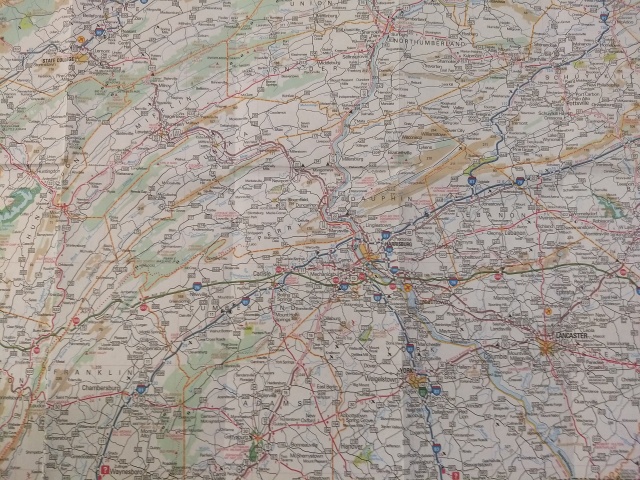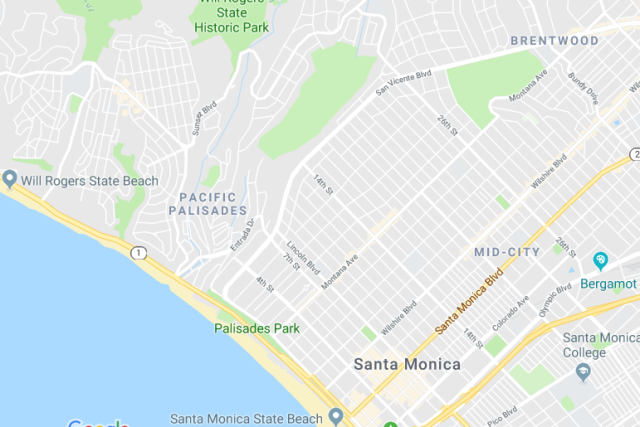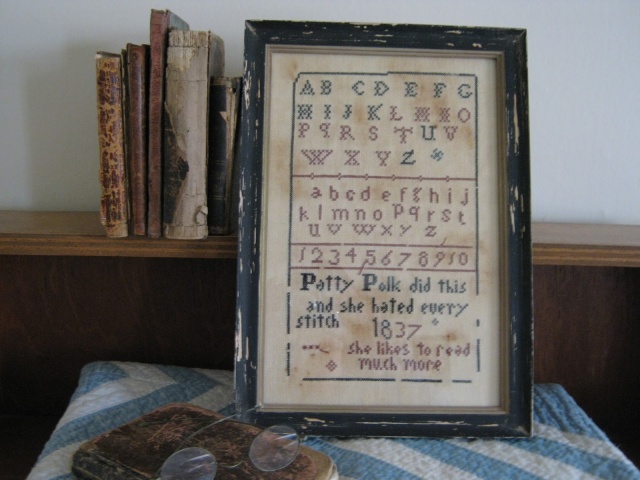Mark Dominus (陶敏修)
mjd@pobox.com

Archive:
| 2025: | JFMAMJ |
| JAS | |
| 2024: | JFMAMJ |
| JASOND | |
| 2023: | JFMAMJ |
| JASOND | |
| 2022: | JFMAMJ |
| JASOND | |
| 2021: | JFMAMJ |
| JASOND | |
| 2020: | JFMAMJ |
| JASOND | |
| 2019: | JFMAMJ |
| JASOND | |
| 2018: | JFMAMJ |
| JASOND | |
| 2017: | JFMAMJ |
| JASOND | |
| 2016: | JFMAMJ |
| JASOND | |
| 2015: | JFMAMJ |
| JASOND | |
| 2014: | JFMAMJ |
| JASOND | |
| 2013: | JFMAMJ |
| JASOND | |
| 2012: | JFMAMJ |
| JASOND | |
| 2011: | JFMAMJ |
| JASOND | |
| 2010: | JFMAMJ |
| JASOND | |
| 2009: | JFMAMJ |
| JASOND | |
| 2008: | JFMAMJ |
| JASOND | |
| 2007: | JFMAMJ |
| JASOND | |
| 2006: | JFMAMJ |
| JASOND | |
| 2005: | OND |
In this section:
Subtopics:
| Mathematics | 245 |
| Programming | 99 |
| Language | 95 |
| Miscellaneous | 75 |
| Book | 50 |
| Tech | 49 |
| Etymology | 35 |
| Haskell | 33 |
| Oops | 30 |
| Unix | 27 |
| Cosmic Call | 25 |
| Math SE | 25 |
| Law | 22 |
| Physics | 21 |
| Perl | 17 |
| Biology | 16 |
| Brain | 15 |
| Calendar | 15 |
| Food | 15 |
Comments disabled
Fri, 28 Mar 2025
Does someone really have to do the dirty jobs?
Doing the laundry used to be backbreaking toil. Haul the water, chop the wood, light the fire, heat the water, and now you are ready to begin the really tough part of the work. The old saying goes "Wash on Monday", because Monday is the day after your day of rest, and otherwise you won't have the strength to do the washing.
And the saying continues: “Iron on Tuesday, mend on Wednesday”. Routine management of clothing takes half of the six-day work week.
For this reason, washing is the work of last resort for the poorest and most marginal people. Widows are washerwomen. Prisons are laundries. Chinese immigrants run laundries. Anyone with enough money to outsource their laundry does so.
The invention of mechanical washing machines eliminated a great amount of human suffering and toil. Machines do the washing now. Nobody has to break their back scrubbing soiled linens against a washboard.
 “Eskimo child with wooden tub and
washboard”, c. 1905, by Frank
Hamilton Nowell, public domain, via
Wikimedia Commons.
“Eskimo child with wooden tub and
washboard”, c. 1905, by Frank
Hamilton Nowell, public domain, via
Wikimedia Commons.
But the flip side of that is that there are still poor and marginalized people, who now have to find other work. Mechanical laundry has taken away their jobs. They no longer have to do the backbreaking labor of hand laundry. Now they have the option to starve to death instead.
Is it a net win? I don't know. I'd like to think so. I'd like to free people from the toil of hand laundry without also starving some of them to death. Our present system doesn't seem to be very good at that sort of thing. I'm not sure what a better system would look like.
Anyway, this is on my mind a lot lately because of the recent developments in computer-generated art. I think “well, it's not all bad, because at least now nobody will have to make a living drawing pornographic pictures of other people's furry OCs. Surely that is a slight elevation of the human condition.” On the other hand, some of those people would rather have the money and who am I to deny them that choice?
[Other articles in category /misc] permanent link
Thu, 06 Mar 2025Around here, these metal things are commonly found on streetside utility poles, attached maybe a meter off the ground.
When I first noticed one of these I said “I wonder what the holes are for. Maybe to make it more visible? And what do they do with all the leftover rectangles after they've made one?”
I eventually got a better idea: The little metal rectangles are the primary product, and after they have been die-cut out of the metal sheet, there is this waste material left over with all the holes. Instead of throwing it away someone nails it to a utility pole to make the pole easier to see at night. I felt a bit silly that my first idea had been exactly backwards.
I later learned that only the older ones are made of sheet metal. Newer ones are made of some sort of plastic, maybe polyethylene or vinyl or something, about the same thickness. They look pretty much the same. I can only tell them apart by feeling them.
Still I wondered what the little rectangles had been used for. It turns out that the purpose is this:
That's according to an old Philadelphia Inquirer article, Why yellow grids are on some Philly-area utility poles. (Patricia Madej, Aug. 31, 2019.) But I measured them to make sure. They matched.
The answer came as a bit of a surprise to Jay Lipschutz, 73, of Northeast Philly …
His wife, Ruth, he said, had insisted they’re reflectors for drivers to see. She was right.
Jay, my friend, your wife is smarter than you are. Listen to her.
The article also tells us that the rectangular leftover is called a “grid reflector”. With a little more research I learned that one manufacturer of grid reflectors is Almetek. They cost $3.50 each. Pricey, for something they would have had to throw away. (Here's the old South Philly Review article that put me on to Almetek.)
What kicked off this article was that I was walking around and I saw this similar reflector grid, which felt to me like it was a bit of a farce, like a teenager sneaking into a bar wearing a fake mustache:
Hey, those aren't holes! When I saw this one I wondered for a moment if I was suffering some sort of mental collapse, or if none of the others had had real holes either. But no, they had, and this one really did have fake holes.
(Also, it has been installed sideways. Normally they are oriented as the two above.)
This isn't the first time I have written about ID numbers on utility poles hereabouts.
[Other articles in category /misc] permanent link
Thu, 06 Feb 2025Last week I complained about a Math SE pathology in which OP asks a simple question, and instead of an answer gets an attempt at a socratic dialog. I ended by saying:
I have been banging this drum for decades, but I will cut the scroll here. Expect a followup article.
Seeing this, Scott Francis remarked:
when you say “I have been banging this drum for decades" I hear echoes of EFnet #perl in the back of my head :)
And yes, that is one of the things I was thinking of.
Thirty years ago the regulars in the #perl IRC channel would play a
cruel teasing game. A stranger would come into the channel and ask a
simple technical question, like “how do I remove the first character
from a string?”
Instead of giving the answer, two or three people would reply perldoc
perlre.
In case it's not obvious — and there is no reason why it should be — this means you can run this command to get the manual for how to use Perl regular expressions.
This manual was about 20,000 words long.
People indulging in this shitty behavior would excuse themselves by
chanting the maxim “If you give a man a fish, he can eat for one day.
If you teach him to fish, he can eat for his whole life.” An actual
answer to a question was a “fish”. Apparently, saying perldoc
perlre was considered to be “teaching a man to fish.”
If the newbie objected that the reply perldoc perlre was unhelpful,
the regulars were only too ready to lecture them on why it was helpful
actually, on why they didn't deserve a better answer, on why they
shouldn't expect their questions to be answered, on how they were
being rude by rejecting the help that was offered them, on how they
shouldn't feel entitled to answers, and on why the regulars there were
all very busy people with more important things to do than to answer
stupid newbie questions.
In my view, someone who is hanging around in #perl should expect
newbie questions, and if they don't want to answer newbie questions
they simply shouldn't do it, they should ignore them. If they can't
do that, if they are so enraged by newbie questions that it ruins the
rest of the chat for them, they should go start a different channel
with a name that won't attract newbies. But they should not hang
around and vent their impotent rage on the newbies who inevitably do
show up.
I'm kind of an asshole, but I'm not that big an asshole. I'm callous, but I'm not sadistic. Someone who says they don't have time to help you, but who does have time to explain to you in detail why they aren't helping you, is sadistic.
“Well, we want them to learn to read the manual,” the regulars would claim. Maybe so, but I don't think their strategy was usually effective. If one really wants people to read the manual, a much better strategy would be to answer the question, and then having established oneself as a helpful person, suggest the manual:
By the way, you can get complete documentation about regexes with the command
perldoc perlre. It's really long, but it's full of useful information. The^operator I mentioned is in the section called "Metacharacters". Would you like help finding it?
On the other hand if what one actually wanted was to convince someone
that Perl was a language used by assholes and they might have better
success with a different language whose community had fewer
assholes, then the #perl regulars’ strategy was probably very
effective.
Then as now my usual habit was to just answer the question. There
would be this odd little moment where three people would say perldoc
perlre and I would say $string =~ s/^.//. Did people yell at me
for this? I don't remember. Probably, I was spoiling their fun.
But at least once someone asked me (in good faith, I'm sure) why I did it my way. I saved my answer. It was:
Because it's easy. Because it's helpful. Because I think the theory that says that people will become dependent on it is bullshit.
Because I think the theory that says that telling them to read the man page is more helpful is also bullshit.
Because in my experience people are much more likely to heed your suggestion to read the man page after you have established that you are a helpful concerned person by assisting them.
The main points are the first two: Because it's easy, and because it's helpful, so why not?
It's at least 25 years later and I'm still angry about this. Who the hell hangs around in a help forum for the purpose of refusing to help?
Social media now is toxic in ways we couldn't have imagined then. But let's not forget that it could be pretty toxic then too.
Addenda
“in good faith, I'm sure” is not sarcasm.
20250208
The previous addendum was also not sarcasm.
[Other articles in category /misc] permanent link
Sat, 31 Aug 2024
Another corner of Pennsylvania
A couple of years back I wrote:
I live in southeastern Pennsylvania, so the Pennsylvania-New Jersey-Delaware triple point must be somewhere nearby. I sat up and got my phone so I could look at the map, and felt foolish.
As you can see, the triple point is in the middle of the Delaware River, as of course it must be; the entire border between Pennsylvania and New Jersey, all the hundreds of miles from its northernmost point (near Port Jervis) to its southernmost (shown above), runs right down the middle of the Delaware.
I briefly considered making a trip to get as close as possible, and photographing the point from land. That would not be too inconvenient. Nearby Marcus Hook is served by commuter rail. But Marcus Hook is not very attractive as a destination. Having been to Marcus Hook, it is hard for me to work up much enthusiasm for a return visit.
I was recently passing by Marcus Hook on the way back from Annapolis, so I thought what the heck, I'd stop in and see if I could get a look in the direction of the tripoint. As you can see from this screencap, I was at least standing in the right place, pointed in the right direction.
I didn't quite see the tripoint itself because this buoyancy-operated aquatic transport was in the way. I don't mind, it was more interesting to look at than open water would have been.
Thanks to the Wonders of the Internet, I have learned that this is an LPG tanker. Hydrocarbons from hundreds of miles away are delivered to the refinery in Marcus Hook via rail, road, and pipeline, and then shipped out on vessels like this one. Infrastructure fans should check it out.
I was pleased to find that Marcus Hook wasn't as dismal as I remembered, it's just a typical industrial small town. I thought maybe I should go back and look around some more. If you hoped I might have something more interesting or even profound to say here, sorry.
Oh, I know. Here, I took this picture in Annapolis:
Perhaps he who is worthy of honor does not die. But fame is fleeting. Even if he who is worthy of honor does get a plinth, the grateful populace may not want to shell out for a statue.
[Other articles in category /misc] permanent link
Sat, 24 Aug 2024Marnanel Thurman reported the following item that they found in an 1875 book titled How to Entertain a Social Party:
To Make a Loaf of Bread Dance on the Table.
— Having a quill filled with quicksilver and stopped close, you secretly thrust it into a hot roll or loaf, which will put it in motion.
(Bottom of page 46.) No further explanation is given.
This may remind you of an episode from Huckleberry Finn:
Well, then I happened to think how they always put quicksilver in loaves of bread and float them off, because they always go right to the drownded carcass and stop there.
When I first read this I assumed it was a local Southern superstition, characteristic of that place and time. But it seems not! According to this article by Dan Rolph of the Historical Society of Pennsylvania, the belief was longstanding and widespread, lasting from at least 1767 to 1872, and appearing also in London and in Pennsylvania.
Details of the dancing bread trick are lacking. I guess the quicksilver stays inside the stopped-up quill. (Otherwise, there would be no need to “stop it close”.) Then perhaps on being heated by the bread, the quicksilver expands lengthwise as in a thermometer, and then… my imagination fails me.
The procedure for making drowned-body-finding bread is quite different. Rolph's sources all agree: you poke in your finger and scoop out a bit of the inside, pour the quicksilver into the cavity, and then plug up the hole. So there's no quill; the quicksilver is just sloshing around loose in there. Huckleberry Finn agrees:
I took out the plug and shook out the little dab of quicksilver…
Does anyone have more information about this? Does hot bread filled with mercury really dance on the table, and if so why? Is the supersition about bread finding drowned bodies related to this, or is it a coincidence?
Also, what song did the sirens sing, and by what name was Achilles called when he hid among women?
[Other articles in category /misc] permanent link
Fri, 12 Jul 2024Toph and I were discussing the story of Loki and Skaði, one of my favorites. (Previously.) The Æsir have killed Skaði's father, and owe her compensation. She has been sad since her father died, she says, and demands that the Æsir make her laugh. Loki rubs his hands together and says "Leave this to me!".
He takes a rope, ties one end to a goat's beard, and the other and to his scrotum. Hilarity ensues.
Skaði tries not to laugh. She fails.
Toph asked a question I had not thought of, but that has been in my head ever since: "Do you think it was an idea he thought up on the spur of the moment? Or was it a bit he had planned ahead of time?"
Wow, I don't know. Was Loki suddenly struck with brilliant inspiration? Or did he think 'Aha, I knew this idea would come in handy sooner or later!' They're both plausible, right?
[Other articles in category /misc] permanent link
Mon, 15 Apr 2024I thought about this because of yesterday's article about the person who needed to count the 3-colorings of an icosahedron, but didn't try constructing any to see what they were like.
Around 2015 Katara, then age 11, saw me writing up my long series of articles about the Cosmic Call message and asked me to explain what the mysterious symbols meant. (It's intended to be a message that space aliens can figure out even though they haven't met us.)
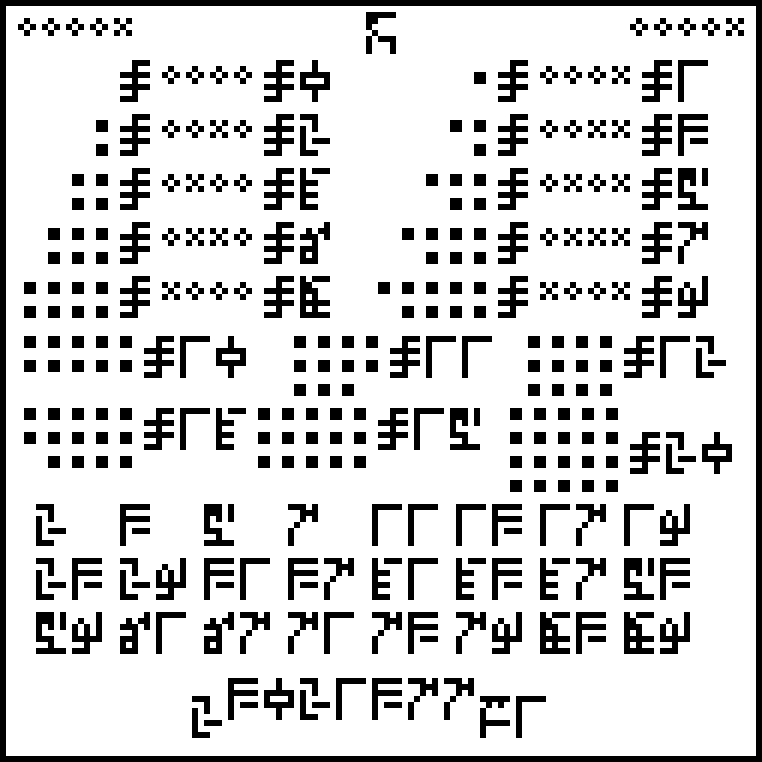
I said “I bet you could figure it out if you tried.” She didn't believe me and she didn't want to try. It seemed insurmountable.
“Okay,” I said, handing her a printed copy of page 1. “Sit on the chaise there and just look at it for five minutes without talking or asking any questions, while I work on this. Then I promise I'll explain everything.”
She figured it out in way less than five minutes. She was thrilled to discover that she could do it.
I think she learned something important that day: A person can accomplish a lot with a few minutes of uninterrupted silent thinking, perhaps more than they imagine, and certainly a lot more than if they don't try.
I think there's a passage somewhere in Zen and the Art of Motorcycle Maintenance about how, when you don't know what to do next, you should just sit with your mouth shut for a couple of minutes and see if any ideas come nibbling. Sometimes they don't. But if there are any swimming around, you won't catch them unless you're waiting for them.
Addenda
20240924
Here's a nice example of this from long ago:
I had never been able to decipher the Latin text, but I had never tried very hard before. So I stared at it for a few minutes.…
After quite a lot of staring, I came to two conclusions:
- I can't make head or tail of most of it, but
- the fourth line begins mella locustis.
Mella locustis is very suggestive. …
And in fact that was the key to figuring out the whole thing. It had been right in front of my face for years (literally, I had a framed copy hanging next to the toilet) but I could never read any of it until I made an effort to just look at it.
[Other articles in category /misc] permanent link
Wed, 14 Feb 2024
The pleasures of dolmen-licking
Ugh, the blog has been really stuck lately. I have lots of good stuff in process but I don't know if I will finish any of it, which would be a shame, because it's good stuff and I have put a lot of work into it. So I thought maybe I should make an effort to relax my posting standards for a bit. In fact I should make an effort to relax them more generally. But in particular, today. So,
here is a picture of me licking a dolmen.
Here is Michael G. Schwern licking the same dolmen.
Not on the same day, obviously. As far as I know we were not in the country at the same time. The question is in my mind: who was the first of us to lick the dolmen? I think he was there before me. But I also wonder: when I decided to lick it, did I know he had done the same thing? It's quite possible that Marty Pauley or someone said to me “You know, when Schwern was here, he licked it,” to which I would surely have responded “then I shall lick it as well!” But it's also possible that we licked the dolmen completely independently, because why wouldn't you? How often to you get a chance to taste a piece of human prehistory?
As a little kid you discover that the world is full of all sorts of fascinating stuff that you may be allowed to look at, but not to touch, and certainly not to climb on or to lick. (“Don't put it in your mouth!”) Dolmens are a delightful exception to this rule. Sure, lick the dolmen all you want. It has stood in the same place for five thousand years, and whether it stands there for five thousand more will not be affected by any amount of licking.
My inner four-year-old was very satisfied the day I licked the dolmen. I imagine that Schwern felt the same way.
[Other articles in category /misc] permanent link
Wed, 09 Aug 2023
No plan survives contact with the enemy
According to legend, champion boxer Mike Tyson was once asked in an interview if he was worried about his opponent's plans. He said:
Everyone has a plan till they get punched in the mouth.
It's often claimed that he said this before one of his famous fights with Evander Holyfield, but Quote Investigator claims that it was actually in reference to his fight with Tyrell Biggs.
Here's how Wikipedia says the fight actually went down:
Biggs had a solid 1st round, connecting with over half of jabs while limiting Tyson to only three. Biggs would continue to use this tactic early in round 2, but Tyson was able to connect with a big left hook that split Biggs' lip open. By round 3, Biggs had all but abandoned his gameplan and …
Tyson's prediction was 100% correct! He went on to knock out Biggs seventh round.
Note
The actual quote appears to have been more like “Everybody has plans until they get hit for the first time”. The “punched in the mouth” version only seems to date back to 2004.
Further research by Barry Popik.
[Other articles in category /misc] permanent link
Fri, 04 Aug 2023The standard individual U.S. Army ration since 1981, the so-called “Meal, Ready-to-Eat”, is often called “three lies for the price of one”, because it is not a meal, not ready, and not edible.
[Other articles in category /misc] permanent link
Tue, 09 May 2023My observation that the Moral Majority was neither moral nor a majority had been made many times before. This is not surprising as it was obvious from day one.
Many people suggested other examples, most of which I rejected for the same reason as “Country Crock”: fanciful brand names are not lies, are not (usually) misunderstood, and are not (normally) intended to deceive.
Instead I would like to offer the phrase “egg cream”. This is a beverage made from milk, seltzer water, and chocolate syrup. (Less commonly, some other flavoring.) It contains neither eggs nor cream. And it is deceptive, since people ordering an egg cream are often under the impression that it will contain eggs or cream.
Finally, if you are still sour about the name “Country Crock” margarine and about brand names generally, you might be able to cheer up if you contemplate the proud proclamation of the truth in the brilliantly confident “I can't believe it's not Butter!”
[ Addendum 20230805: Three lies in one. ]
[Other articles in category /misc] permanent link
Mon, 24 Apr 2023Cynicism seems to many people like an unlimited resource. But it is like fiat currency in that it becomes valueless and contemptible when there is too much in circulation.
Cynicism should be saved, and used only when necessary.
[Other articles in category /misc] permanent link
Thu, 13 Apr 2023A New Yorker magazine profile of The Simpsons writer George Meyer says:
He is especially interested in examples of ad copy in which the word-to-falsehood ratio approaches one. He once showed me a magazine advertisement for a butter substitute called Country Crock. “It’s not from the country; there is no crock,” he said. “Two words, two lies.”
I think of this every time I am in the supermarket and see the Country Crock. I have always felt it was a weak example.
A lie is intended to deceive, and I believe the marketing people at Country Crock never expected anyone to think that it was actually from the country or actually in a crock. Most adults understand that brand names are not literally descriptive and are only intended to be fanciful and evocative. Meyer is being kind of a putz here.
I was going to include a list of non-descriptive brand names, but I don't think it would persuade anyone who disagrees with me. If you would like one anyway, consider Log Cabin pancake syrup. If you want to claim this is a ‘lie’, what is the lie? If not, what is the practical difference between Log Cabin pancake syrup and Country Crock margarine?
I would like to help out George Meyer by proposing a genuinely dishonest example.
How about “Moral Majority”?
[ Addendum 20230509: A followup. ]
[ Addendum 20230805: Three lies in one. ]
[Other articles in category /misc] permanent link
Sat, 01 Apr 2023
United States first names of newborns 1960–2021
Various United States government agencies keep statistics of forenames and surnames, which I have often found useful, but which can be hard to find. I am storing them here for future convenience. The data is in the public domain. Share and enjoy.
- 3162 CSV files in
.tgzformat (3.1 MB) - 3162 CSV files in Zip format (4.6 MB)
- To retrieve individual files, browse the directory
What's here?
A collection of 62×51 = 3162 CSV files with names dddd-XX.csv, where
dddd is a four-digit year between 1960 and 2021, and XX is a
standard two-letter state abbreviation, or DC. (Information for
Puerto Rico and other U.S. territories was
available from the SSA
but I did not collect it.)
By the way, !!3162\approx\sqrt{1000000}!!.
File format
Each file contains at least 200 records in the following format:
1960,AK,M,David,152
1960,AK,F,Mary,79
The fields are: year; state; sex; name; count. The (year, state, sex, name) tuple is a unique key over the entire data set.
The count is the number of babies with the specified name and sex born that year in that state. For example, the records above indicate that there were 152 male babies named David born in Alaska in year 1960, and 79 female babies named Mary.
At least the 100 most common names for each year-state-sex triple are included. I believe that the extra records are included when the least common names are tied for frequency.
Provenance
The United States social security administration (SSA) provides a web form that will deliver data for one year-state pair. I automated 3162 requests to this form and then scraped the HTML output.
(A couple of months ago I found a source for the raw data, as a single easy download, and then forgot where it was. Hence this post.)
Caution: data contains errors
There are several possible sources of error in these files. Most obviously, I might have made a mistake in the extraction, scraping, or recording.
But also it seems to me that the SSA itself provided some bad data. The data for Kentucky for year 2004 is clearly incorrect.
The name “Jacob” for girls is not to be found in the data — except in
the 2004-KY.csv file. The SSA claims that there were 130 baby girls
in Kentucky that year named Jacob,
making it the 17th most common female name, ahead of Anna and just
behind Lauren.
The same file contains
many similar oddities.
For example, it claims that there were
dozens of boys named Hannah and Emily, and
dozens of girls named Michael, Joseph, and Christopher,
but only that year and only in Kentucky.
I've added a comment to the top of the 2004-KY.csv file, which I
hope will cause a processing failure so that nobody uses it accidentally.
I have contacted the SSA web site but I am not hopeful that this will be corrected. [ Update 20230413: Here is their completely nonresponsive reply to my bug report. ]
Update 20230812: I recently discovered that some of the files contain entries for people named “Unknown”, and the 1989 Wisconsin file contains entries for 158 people named “Unnamed”. Also, there are no other names in any of files that begin with letter ‘U’. Really? Hundreds of Xaviers and Ximenas, but no significant numbers of Ulysseses or Ursulas? I don't know whether this is another error.
If you notice other likely errors, please bring them to my attention.
Data limitations
The SSA has a page of qualifications about the data.
Since I expect this page will outlast the SSA's, here is an archived copy.
What for?
A coworker recently mentioned that, of the 37 people who attended the most recent meeting of his (California) church youth group, no two had the same name. He asked if this was remarkable. (My conclusion: only somewhat; the computed probability was around 1 in 5, and would be higher if I hadn't had to ignore the long tail of names that aren't in the files.)
More recently, I had an argument with ChatGPT about whether the name “James” was commonly used for women. It is not listed as one of the top 100 names in any state for the last 60 years, except in the obviously erroneous Kentucky 2004 data, as I mentioned above.
[Other articles in category /misc] permanent link
Fri, 10 Feb 2023The aphorism about looking for your lost wallet under the lamppost applies differently in two different kinds of situations:
If you know you lost your wallet in the dark alley, looking for it under the lamppost "because the light is better" is a self-deceptive waste of time.
(That's the sense in which it appears in the original joke.)
But if you don't know exactly where you lost your wallet, it's good strategy to look for it first under the lamppost, where the light is better, as long as you are prepared to move on to the dark alley later.
(People often invoke it in this sense instead.)
[Other articles in category /misc] permanent link
Mon, 12 Sep 2022
Coat of arms of Zeppelin-Wappen
"Can we choose a new coat of arms?"
"What's wrong with the one we have?"
"What's wrong with it? It's nauseated goat!"
"I don't know what your problem is, it's been the family crest for generations."
"Please, I'm begging."
"Okay, how about a compromise: I'll get a new coat of arms, but it must include a reference to the old one."
"I guess I can live with that."

[ Source: Wikipedia ]
[Other articles in category /misc] permanent link
Sat, 26 Mar 2022For a long while I've been planning an article about occupational surnames, but it's not ready and this is too delightful to wait.
There is, in California, a dermatologist named:
Awesome.
“Wala” is an Indian-language suffix that indicates a person who deals in, transports, or otherwise has something to do with the suffixed thing. You may have heard of the famous dabbawalas of Mumbai. A dabba is a lunchbox, and in Mumbai thousands of dabbawalas supply workers with the hot lunches that were cooked fresh in the workers’ own homes that morning.
Similarly, an icecreamwala is an ice cream vendor. Apparently there was some point during the British Raj that the Brits went around handing out occupational surnames, and at least one ice cream wala received the name Icecreamwala.
It is delightful enough that Dr. Icecreamwala exists, but the story gets better. Icecreamwala is her married name. She was born Devika Patel. Some people might have stuck with Patel, preferring the common and nondescript to the rare and wonderful. Not Dr. Icecreamwala! She not only changed her name, she embraced the new one. Her practice is called Icecreamwala Dermatology and their internet domain is icecreamderm.com.
Ozy Brennan recently considered the problem of which parent's surnames to give to the children. and suggested that they choose whichever is coolest. Dr. Icecreamwala appears to be in agreement.
[ Addendum 20220328: Vaibhav Sagar informs me that Icecreamwala is probably rendered in Hindi as आइसक्रीमवाला. ]
[Other articles in category /misc] permanent link
Sat, 05 Feb 2022Today I learned that Julie Cypher, longtime partner of Melissa Etheridge, was actually born under the name Julie Cypher. Her dad's last name was Cypher, and it's apparently not even a very rare name.
It happens pretty often that I run into names and say to myself “wow, I'm glad that's not my name”. Or even “that's a cool name, but not as cool as ‘Dominus’.” But ‘Cypher’ is as cool as ‘Dominus’.
[ Addendum: I have mentioned before that Dominus is my birth name, not a recent invention. It came from Hungary, where it is in wider use than it is here. ]
[ Addendum 20220315: Today's “wow, I'm glad that's not my name” moment was in connection with Patience D. Roggensack. If you were writing a novel and gave a character that name, people would complain you were being precious. ]
[Other articles in category /misc/til] permanent link
Sat, 22 Jan 2022A couple of weeks ago I had this dumb game on my phone, there are these characters fighting monsters. Each character has a special power that charges up over time, and then when you push a button the character announces their catch phrase and the special power activates.
This one character with the biggest hat had the catch phrase
I follow my own destiny!
and I began to dread activating this character's power. Every time, I wanted to grab them by the shoulders and yell “That's what destiny is, you don't get a choice!” But they kept on saying it.
So I had to delete the whole thing.
[Other articles in category /misc] permanent link
Wed, 19 Jan 2022The news today contains the story “Italian Senate Accidentally Plays 30 Seconds Of NSFW Tifa Lockhart Video” although I have not been able to find any source I would consider reliable. TheGamer reports:
The conference was hosted Monday by Nobel Prize winner Giorgio Parisi and featured several Italian senators. At some point during the Zoom call, a user … broke into the call and started broadcasting hentai videos.
Assuming this is accurate, it is disappointing on so many levels. Most obviously because if this was going to happen at all one would hope that it was an embarrassing mistake on the part of someone who was invited to the call, perhaps even the Nobel laureate, and not just some juvenile vandal who ran into the room with a sock on his dick.
If someone was going to go to the trouble of pulling this prank at all, why some run-of-the mill computer-generated video? Why not something really offensive? Or thematically appropriate, such as a scene from one of Cicciolina's films?
I think the guy who did this should feel ashamed of his squandered opportunity, and try a little harder next time. The world is watching!
[Other articles in category /misc] permanent link
Tue, 18 Jan 2022This morning Katara and I were taking our vitamins, and Katara asked why vitamin K was letter “K”.
I said "It stands for ‘koagulation’.”
“No,” replied Katara.
“Yes,” I said.
“No.”
“Yes.”
By this time she must have known something was up, because she knows that I will make up lots of silly nonsense, but if challenged I will always recant immediately.
“‘Coagulation’ doesn't start with a ‘K’.”
Lorrie says she discovered the secret to dealing with me, thirty years ago: always take everything I say at face value. The unlikely-seeming things are true more often than not, and the few that aren't I will quickly retract.
[Other articles in category /misc] permanent link
Sun, 16 Jan 2022I don't even want to know what happened here.

All I can think of is this guy:
[ Addendum: Joe Ardent informs me that the suggestions are actually provided by Goofle. ]
[Other articles in category /misc] permanent link
Sat, 06 Nov 2021
History of Science Shitcommenting
A recent post on History of Science and Mathematics stack exchange asks:
What makes the right angle special enough to be distinguished in the French metric system?
…
Why was the right angle chosen? A somewhat equivalent question: Out of all possible angles, why is the right angle particularly special?
This kind of question astounds me. It reminds me of this episode from Understood Betsy:
She weighed out the salt needed on the scales, and was very much surprised to find that there really is such a thing as an ounce. She had never met it before outside the pages of her arithmetic book, and she didn't know it lived anywhere else.
Does this person seriously not know what a right angle is, apart from some formal definition involving ninety degrees or whatever? Do they know that a right angle lives outside the pages of a mathematics text? Maybe not!
Anyway, I was shocked, and left this comment:
RIGHT ANGLE SPECIAL. IF WALL NOT BUILT AT RIGHT ANGLE TO GROUND, FALL DOWN.
I expected this would be quickly deleted, and might even earn me a reprimand from the moderators. It didn't, and now has seven upvotes.
[Other articles in category /misc] permanent link
Wed, 27 Oct 2021Is the idea here that If you're watching the pot, it'll seem like it takes longer than it should?
Or is the idea that if you keep taking the lid off to check if it's boiling yet, the heat will escape and it will actually take longer than it should?
[Other articles in category /misc] permanent link
Fri, 01 Oct 2021
Ida-related flooding in Philadelphia
On September 1, Hurricane Ida hit Pennsylvania. Several tornadoes touched down near where I live in Philadelphia, and five people were killed. Fortunately Philadelphia itself was spared, and from where I live it only appeared to be an unusually-heavy rainstorm.
But Philadelphia is on the Schuylkill River, and all the water that Ida dumped northwest of Philadelphia ended up in the Schuylkill, which flooded epically and historically.
I-95 and I-76 also run through Philadelphia, and connecting them, in a deep trench along the northern boundary of the business district, is the Vine Street Expressway. Normally it looks like this:
(Google Street View, July 2019)
But on September 1 it looked like this:
Holy cow. I'd never seen anything like this before. How long would the expressway be shut down? I had no idea.
Toph and I went up there on September 4 to see the damage, but by then there wasn't much to see. It looked like this:
Traffic was flowing normally in the eastbound lane (far side). The westbound lane (near side, with the cone) was still closed but it was obvious that they were finishing the cleanup. That's some amazing work. I have no idea how you even begin to get something like that cleaned up, and no idea how to get it done in three days.
The streets were a little dirtier than usual, but if I hadn't known to look I probably wouldn't have noticed. (Philadelphia.) We did pass houses that had piles of ruined books outside, and we encountered two gentlemen who were glumly carrying out loads of soggy carpet from their flooded basement.
We walked on the path that runs by the river, which is normally about two or three meters above the level of the river itself. The river didn't look higher than usual, but we did see signs of the flood. The path is between the river and the train tracks, and there is a fence to keep you from crossing the tracks.
Here's picture I took on September 4:
The river has piled driftwood and other trash at the base of the fence. The fence itself is clogged with leaves and paper, left there when the river poured through it as through a sieve. The river not only overtopped its banks and flooded the footpath, it must have reached at least to the top of the fence.
Here's another shot of the fence. Over here the sieve became too clogged to let the water through and the entire fence collapsed. The on-ramp for the expressway is visible in the background.
Here's Google's Street View picture of what the fence was like in July 2016:
I have no special point to make, and leave you with this, which I think should be part of the Philadelphia historical archives. Content warning: unsanitary behavior.
[Other articles in category /misc] permanent link
Sat, 28 Aug 2021On Twitter, Mike Coutermarsh suggested:
Job interview: “algorithms”
Reality: “Turn a 127 message deep slack thread between 5 engineers into a decision”
I suppose this was meant facetiously but I think it might contain the germ of a good idea.
Applicants are usually given timed a programming quiz. What if instead, the candidate was supplied with the 127-message Slack thread and given 24 hours to write up a proposal document? I honestly think this might produce good results.
Such a submission would be extremely probative of the candidate's talents and abilities, including:
- reading and understanding technical arguments
- balancing engineering tradeoffs
- foreseeing potential issues
- writing clear English
- planning
- seriousness
- writing coherent, well-organized, and persuasive documents
It is much more difficult to cheat on this task than on a typical programming exercise. The candidate certainly can't submit a prewritten essay that they found somewhere; that would be easy to detect. A candidate who can take someone else's prewritten essay and quickly rewrite it to plausibly appear original is probably quite well-qualified on many of the important metrics! (Plus an additional important one: the ability to do research. They had to locate, recognize, and read the essay they rewrote.)
It shouldn't be hard to change up the essay topic periodically, since the engineers will be producing several of those 127-message Slack threads every month. This also tends to impede cheating.
When a good candidate comes for an in-person interview, you have a ready-made topic of conversation. Instead of coding at the whiteboard, you can ask them to discuss their proposal.
Complaints that this would discriminate against candidates with poor command of English do not hold water. Good command of English is one of the job requirements, and the whole point of a job interview is to discriminate against unqualified candidates. Besides, if the hiring process encourages candidates to improve their English writing abilities, rather than cramming a bunch of red-black-tree algorithms, language trivia, or irrelevant brainteasters, so much the better for everyone.
[Other articles in category /misc] permanent link
Fri, 26 Mar 2021
Something I didn't know and I bet you didn't either
The Panama Canal has a loyalty program.
If you're planning to ship at least 450,000 TEU per year, you can register in advance and get a discount on your tolls.
[Other articles in category /misc] permanent link
Sun, 21 Mar 2021
Two sentences that made me stop to think
In The ancient fabric that no one knows how to make:
Islam was born in Bangladesh and moved to London about 20 years ago.
Whaaaat? Then I realized: It's someone named “Islam”. Okay.
In Wikipedia's article on some comic book person called “Steppenwolf”:
His decapitated head is crushed by the foot of Darkseid, enraged by his lieutenant's failure.
For this to be correct, Steppenwolf would have to have a second head growing out of his main head. Then if someone cut off the second head, the main head would be a decapitated head.
Not out of the question for a comic book person, but in this case not correct. I changed it to “disembodied head”.
[ Addendum 20210322: Shortly afterward, another editor changed it to “severed head”, which I agree is better. ]
[Other articles in category /misc] permanent link
Sat, 13 Feb 2021Yesterday I wondered who Robert Altman had cast as Bluto in his 1980 live-action film Popeye. The answer turned out to be Paul L. Smith, who seemingly was born to play the part:
I have thought for years about how Shelley Duval was seemingly born to play the part of Olive Oyl. (I remember the Mad magazine parody making this observation at the time, and it wasn't funny because it was so obvious.) I have somtimes wondered if Altman got the idea to make a Popeye movie specifically so that he could cast Duval as Olive Oyl.
Anyway, Paul L. Smith, who already looked like Bluto. He was in a fair number of TV productions in the 70s and 80s, and I think it's possible that I saw him in one or another one. But the only other role of his that I remember clearly is from David Lynch's 1984 Dune. He plays Glossu “the Beast” Rabban. Who in many ways is not that different from Bluto: Large, violent, dangerous for his brutality but not his cunning.
Obviously the Baron wanted to cast Feyd-Rautha as Popeye, but events got away from him and Paul became Popeye instead. In a Dune-Popeye crossover I can see Alia as Swee'Pea. That means that Chani has to be Olive, which I can live with.
The correspondence isn't perfect, of course. There is nobody in Popeye like Lady Jessica or Stilgar. (Leto is obviously Poopdeck Pappy.) On the other side, where is J. Wellington Wimpy? It's been a while since I read the book, but I don't remember him appearing. Reverend Mother Gaius Helen Mohiam is clearly the Sea Hag.
Me spinach musk flow! If ya controlsk the spinach, ya controlsk the uni-voice! Ag-ag-ag-ag-ag!
[Other articles in category /misc] permanent link
Wed, 03 Feb 2021Katara and I went to visit the town of Gap, PA. In Gap there are so many eagles that they have these special bins for getting rid of the extras.
[Other articles in category /misc] permanent link
Thu, 10 Dec 2020I see that the Pennsylvania-Delaware-Maryland triple border is near White Clay Creek State Park, outside of Newark, DE. That sounds nice, so perhaps I will stop by and take a look, and see if there really is white clay in the creek.
I had some free time yesterday, so that is what I did. The creek is pretty. I did not see anything that appeared to be white clay. Of course I did not investigate extensively, or even closely, because the weather was too cold for wading. But the park was beautiful.
There is a walking trail in the park that reaches the tripoint itself. I didn't walk the whole trail. The park entrance is at the other end of the park from the tripoint. After wandering around in the park for a while, I went back to the car, drove to the Maryland end of the park, and left the car on the side of the Maryland Route 896 (or maybe Pennsylvania Route 896, it's hard to be sure). Then I cut across private property to the marker.
The marker itself looks like this:
As you see, the Pennsylvania sides of the monument are marked with ‘P’ and the Maryland side with ‘M’. The other ‘M’ is actually in Delaware. This Newark Post article explains why there is no ‘D’:
The marker lists only Maryland and Pennsylvania, not Delaware, because in 1765, Delaware was part of Pennsylvania.
This does not explain the whole thing. The point was first marked in 1765 by Mason and Dixon and at that time Delaware was indeed part of Pennsylvania. But as you see the stone marker was placed in 1849, by which time Delaware had been there for some time. Perhaps the people who installed the new marker were trying to pretend that Delaware did not exist.
[ Addendum 20201218: Daniel Wagner points out that even if the 1849 people were trying to depict things as they were in 1765, the marker is still wrong; it should have three ‘P’ and one ‘M’, not two of each. I did read that the surveyors who originally placed the 1849 marker put it in the wrong spot, and it had to be moved later, so perhaps they were just not careful people. ]
Theron Stanford notes that this point is also the northwestern corner of the Wedge. This sliver of land was east of the Maryland border, but outside the Twelve-Mile Circle and so formed an odd prodtrusion from Pennsylvania. Pennsylvania only reliquinshed claims to it in 1921 and it is now agreed to be part of Delaware. Were the Wedge still part of Pennsylvania, the tripoint would have been at its southernmost point.
Looking at the map now I see that to get to the marker, I must have driven within a hundred yards of the westmost point of the Twelve-Mile Circle itself, and there is a (somewhat more impressive) marker there. Had I realized at the time I probably would have tried to stop off.
I have some other pictures of the marker if you are not tired of this yet.
[ Addendum 20201211: Tim Heany asks “Is there no sign at the border on 896?” There probably is, and this observation is a strong argument that I parked the car in Maryland. ]
[ Addendum 20201211: Yes, ‘prodtrusion’ was a typo, but it is a gift from the Gods of Dada and should be treasured, not thrown in the trash. ]
[Other articles in category /misc] permanent link
Sat, 21 Nov 2020
[Other articles in category /misc] permanent link
Thu, 21 May 2020There have been several reports of the theft of catalytic converters in our neighborhood, the thieves going under the car and cutting the whole thing out. The catalytic converter contains a few grams of some precious metal, typically platinum, and this can be recycled by a sufficiently crooked junk dealer.
Why weren't these being stolen before? I have a theory. The catalytic converter contains only a few grams of platinum, worth around $30. Crawling under a car to cut one out is a lot of trouble and risk to go to for $30. I think the stay-at-home order has put a lot of burglars and housebreakers out of work. People aren't leaving their houses and in particular they aren't going on vacations. So thieves have to steal what they can get.
[ Addendum 20200522: An initial glance at the official crime statistics suggests that my theory is wrong. I'll try to make a report over the weekend. ]
[Other articles in category /misc] permanent link
Sun, 26 Apr 2020I ran into this album by Jools Holland:

What do you see when you look at this? If you're me, you spend a few minutes wondering why there is a map of Delaware.
[ Addendum 20250203: Another example, this time a little closer to home. ]
[Other articles in category /misc] permanent link
Fri, 24 Apr 2020
Tiers of answers to half-baked questions
[ This article is itself somewhat half-baked. ]
There's this thing that happens on Stack Exchange sometimes. A somewhat-clueless person will show up and ask a half-baked question about something they are thinking about. Their question is groping toward something sensible but won't be all the way there, and then several people will reply saying no, that is not sensible, your idea is silly, without ever admitting that there is anything to the idea at all.
I have three examples of this handy, and I'm sure I could find many more.
One recent one concerns chirality (handedness) in topology. OP showed up to ask why a donut seems to be achiral while a coffee cup is chiral (because the handle is on one side and not the other). Some people told them that the coffee cup is actually achiral and some others people told them that topology doesn't distinguish between left- and right-handed objects, because reflection is a continuous transformation. (“From a topological point of view, no object is distinguishable from its mirror image”.) I've seen many similar discussions play out the same way in the past.
But nobody (other than me) told them that there is a whole branch of topology, knot theory, where the difference between left- and right-handed objects is a major concern. Everyone else was just acting like this was a nonissue.
This category theory example is somewhat more obscure.
In category theory one can always turn any construction backward to make a “dual” construction, and the “dual” construction is different but usually no less interesting than the original. For example, there is a category-theoretic construction of “product objects”, which generalizes cartesian products of sets, topological product spaces, the direct product of groups, and so on. The dual construction is “coproduct objects” which corresponds to the disjoint union of sets and topological spaces, and to the free product of groups.
There is a standard notion of an “exponential object” and OP wanted to know about the dual notion of a “co-exponential object”. They gave a proposed definition of such an object, but got their proposal a little bit wrong, so that what they had defined was not the actual co-exponential object but instead was trivial. Two other users pointed out in detail why their proposed construction was uninteresting. Neither one pointed out that there is a co-exponential object, and that it is interesting, if you perform the dualization correctly.
(The exponential object concerns a certain property of a mapping !!f :A×B\to C!!. OP asked insead about !!f : C\to A× B!!. Such a mapping can always be factored into a product !!(f_1: C\to A)×(f_2: C\to B)!! and then the two factors can be treated independently. The correct dual construction concerns a property of a mapping !!f : C\to A\sqcup B!!, where !!\sqcup!! is the coproduct. This admits no corresponding simplification.)
A frequently-asked question is (some half-baked variation on) whether there is a smallest positive real number. Often this is motivated by the surprising fact that !!0.9999\ldots = 1!!, and in an effort to capture their intuitive notion of the difference, sometimes OP will suggest that there should be a number !!0.000\ldots 1!!, with “an infinite number of zeroes before the 1”.
There is no such real number, but the question is a reasonable one to ask and to investigate. Often people will dismiss the question claiming that it does not make any sense at all, using some formula like “you can't have a 1 after an infinite sequence of zeroes, because an infinite sequence of zeroes goes on forever.”. Mathematically, this response is complete bullshit because mathematicians are perfectly comfortable with the idea of an infinite sequence that has one item (or more) appended after the others. (Such an object is said to “have order type !!\omega + 1!!”, and is completely legitimate.) The problem isn't with the proposed object itself, but with the results of the attempt to incorporate it into the arithmetic of real numbers: what would you get, for example, if you tried to multiply it by !!10!!?
Or sometimes one sees answers that go no further than “no, because the definition of a real number is…”. But a better engagement with the question would recognize that OP is probably interested in alternative definitions of real numbers.
In a recent blog article I proposed a classification of answers to certain half-baked software questions (“Is it possible to do X?”):
- It surely could, but nobody has done it yet
- It perhaps could, but nobody is quite sure how
- It maybe could, but what you want is not as clear as you think
- It can't, because that is impossible
- I am not able rightly to apprehend the kind of confusion of ideas that could provoke such a question
and I said:
Often, engineers will go straight to #5, when actually the answer is in a higher tier. Or they go to #4 without asking if maybe, once the desiderata are clarified a bit, it will move from “impossible” to merely “difficult”. These are bad habits.
These mathematically half-baked questions also deserve better answers. A similar classification of answers to “can we do this” might look like this:
- Yes, that is exactly what we do, only more formally. You can find out more about the details in this source…
- Yes, we do something very much like that, but there are some significant differences to address points you have not considered…
- Yes, we might like to do something along those lines, but to make it work we need to make some major changes…
- That seems at first like a reasonable thing to try, but if you look more deeply you find that it can't be made to work, because…
- I am not able rightly to apprehend the kind of confusion of ideas that could provoke such a question
The category theory answer was from tier 4, but should have been from tier 2. People asking about !!0.0000…1!! often receive answers from tier 5, but ought to get answers from tier 4, or even tier 3, if you wanted to get into nonstandard analysis à la Robinson.
There is a similar hierarchy for questions of the type “can we model this concept mathematically”, ranging from “yes, all the time” through “nobody has figured that out yet” and “it seems unlikely, because”, to “what would that even mean?”. The topological chirality question was of this type and the answers given were from the “no we can't and we don't” tiers, when they could have been from a much higher tier: “yes, it's more complicated than that but there is an entire subfield devoted to dealing with it.”
This is a sort of refinement of the opposition of “yes, and…” versus “no, but…”, with the tiers something like:
- Yes, and…
- Yes, but…
- Perhaps, if…
- No, but…
- No, because…
- I am embarrassed for you
When formulating the answer to a question, aiming for the upper tiers usually produces more helpful, more useful, and more interesting results.
[ Addendum 20200525: Here's a typical dismissal of the !!0.\bar01!! suggestion: “This is confusing because !!0.\bar01!! seems to indicate a decimal with ‘infinite zeros and then a one at the end.’ Which, of course, is absurd.” ]
[ Addendum 20230421: Another example, concerning “almost orthogonal” unit vectors ]
[Other articles in category /misc] permanent link
Tue, 14 Jan 2020
More about triple border points
[ Previously ]
A couple of readers wrote to discuss tripoints, which are places where three states or other regions share a common border point.
Doug Orleans told me about the Tri-States Monument near Port Jervis, New York. This marks the approximate location of the Pennsylvania - New Jersey - New York border. (The actual tripoint, as I mentioned, is at the bottom of the river.)
I had independently been thinking about taking a drive around the entire border of Pennsylvania, and this is just one more reason to do that. (Also, I would drive through the Delaware Water Gap, which is lovely.) Looking into this I learned about the small town of North East, so-named because it's in the northeast corner of Erie County. It's also the northernmost point in Pennsylvania.
(I got onto a tangent about whether it was the northeastmost point in Pennsylvania, and I'm really not sure. It is certainly an extreme northeast point in the sense that you can't travel north, east, or northeast from it without leaving the state. But it would be a very strange choice, since Erie County is at the very western end of the state.)
My putative circumnavigation of Pennsylvanias would take me as close as possible to Pennsylvania's only international boundary, with Ontario; there are Pennsylvania - Ontario tripoints with New York and with Ohio. Unfortunately, both of them are in Lake Erie. The only really accessible Pennsylvania tripoints are the one with West Virginia and Maryland (near Morgantown) and Maryland and Delaware (near Newark).
These points do tend to be marked, with surveyors’ markers if nothing else. Loren Spice sent me a picture of themselves standing at the tripoint of Kansas, Missouri, and Oklahoma, not too far from Joplin, Missouri.
While looking into this, I discovered the Kentucky Bend, which is an exclave of Kentucky, embedded between Tennessee and Missouri:
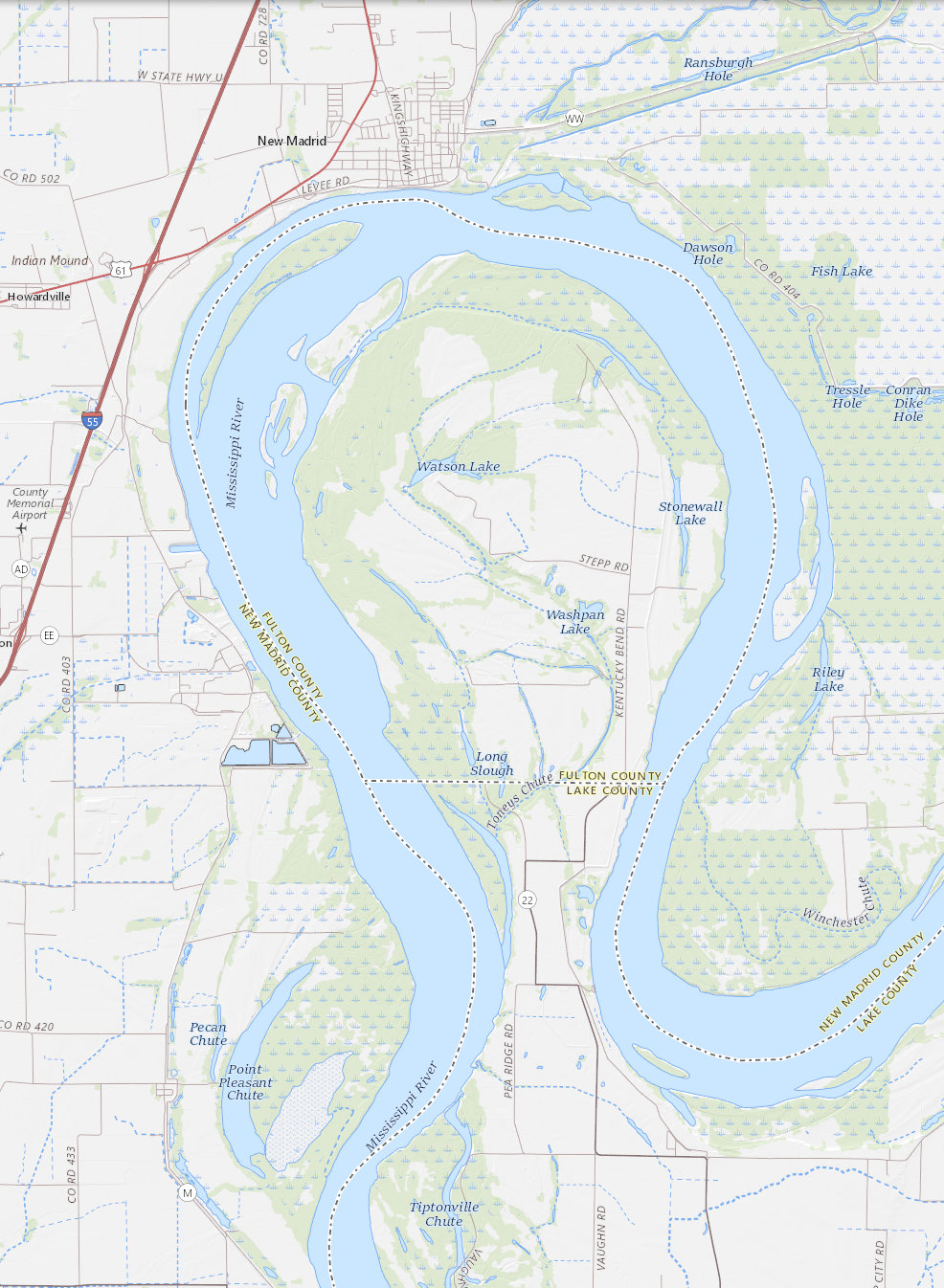
The “bubble” here is part of Fulton County, Kentucky. North, across the river, is New Madrid County, Missouri. The land border of the bubble is with Lake County, Tennessee.
It appears that what happened here is that the border between Kentucky and Missouri is the river, with Kentucky getting the territory on the left bank, here the south side. And the border between Kentucky and Tennessee is a straight line, following roughly the 36.5 parallel, with Kentucky getting the territory north of the line. The bubble is south of the river but north of the line.
So these three states have not one tripoint, but three, all only a few miles apart!

Finally, I must mention the Lakes of Wada, which are not real lakes, but rather are three connected subsets of the unit disc which have the property that every point on their boundaries is a tripoint.
[Other articles in category /misc] permanent link
Thu, 09 Jan 2020I'm a fan of geographic oddities, and a few years back when I took a road trip to circumnavigate Chesapeake Bay, I planned its official start in New Castle, DE, which is noted for being the center of the only circular state boundary in the U.S.:
The red blob is New Castle. Supposedly an early treaty allotted to Delaware all points west of the river that were within twelve miles of the State House in New Castle.
I drove to New Castle, made a short visit to the State House, and then began my road trip in earnest. This is a little bit silly, because the border is completely invisible, whether you are up close or twelve miles away, and the State House is just another building, and would be exactly the same even if the border were actually a semicubic parabola with its focus at the second-tallest building in Wilmington.
Whatever, I like going places, so I went to New Castle to check it out. Perhaps it was silly, but I enjoyed going out of my way to visit a point of purely geometric significance. The continuing popularity of Four Corners as a tourist destination shows that I'm not the only one. I don't have any plans to visit Four Corners, because it's far away, kinda in the middle of nowhere, and seems like rather a tourist trap. (Not that I begrudge the Navajo Nation whatever they can get from it.)
Four Corners is famously the only point in the U.S. where four state borders coincide. But a couple of weeks ago as I was falling asleep, I had the thought that there are many triple-border points, and it might be fun to visit some. In particular, I live in southeastern Pennsylvania, so the Pennsylvania-New Jersey-Delaware triple point must be somewhere nearby. I sat up and got my phone so I could look at the map, and felt foolish:

As you can see, the triple point is in the middle of the Delaware River, as of course it must be; the entire border between Pennsylvania and New Jersey, all the hundreds of miles from its northernmost point (near Port Jervis) to its southernmost (shown above), runs right down the middle of the Delaware.
I briefly considered making a trip to get as close as possible, and photographing the point from land. That would not be too inconvenient. Nearby Marcus Hook is served by commuter rail. But Marcus Hook is not very attractive as a destination. Having been to Marcus Hook, it is hard for me to work up much enthusiasm for a return visit.
But I may look into this further. I usually like going places and being places, and I like being surprised when I get there, so visting arbitrarily-chosen places has often worked out well for me. I see that the Pennsylvania-Delaware-Maryland triple border is near White Clay Creek State Park, outside of Newark, DE. That sounds nice, so perhaps I will stop by and take a look, and see if there really is white clay in the creek.
Who knows, I may even go back to Marcus Hook one day.
Addenda
20190114
More about nearby tripoints and related matters.
20201209
I visited the tripoint marker in White Clay Creek State Park.
20220422
More about how visting arbitrarily-chosen places has often worked out well for me. I have a superstitious belief in the power of Fate to bring me to where I am supposed to be, but rationally I understand that the true explanation is that random walks are likely to bring me to an interesting destination simply because I am easily interested and so find most destinations interesting.
20240831
I have now gone back to Marcus Hook to view the tripoint.
20250215
I somehow forgot to mention that back in August 2022 I made the drive up to Port Jervis to visit the NJ-NY-PA tripoint. It's in the river, of course, but there is a marker nearby on a tiny island that is used as a support for the I84 crossing of the Delaware River. As I recall, I saw a flock of geese.
I don't have the photos handy but I did at least save these screenshots:
The marker is not as hard to get to as it might appear. The rest of the little island is a graveyard, and has a footpath from which you can easily reach the marker. The marker itself is a stone column about four feet high.
[Other articles in category /misc] permanent link
Mon, 04 Nov 2019We have had two of these plastic thingies cluttering up our dish drainer for years. We didn't know what they were but we didn't want to throw them away because what if they are important?
I got tired of them this weekend, and examined one more closely.
There wasn't any indication of what it had been part of, or what it
was for, but it did have the marking PART 2198768 on the back, so I
handed that to The Goog.
And the result was instantaneous and unequivocal: it belongs to my refrigerator. Specifically, it goes in the back of the freezer compartment to keep food from falling down into the back and blocking the drainage path.
Truly, we live in an age of marvels.
[Other articles in category /misc] permanent link
Sun, 03 Nov 2019I suddenly wondered: was Andy Warhol ever a TV show guest star? So I asked the Goog, and the answer was better than I could have imagined: in October 1985, Andy Warhol was a guest star on The Love Boat.
According to Wikipedia, one of the subpots of the episode was “a woman avoids Warhol, wanting to forget the time she was in one of his movies.” That is a lot more plausible than many Love Boat plots!
Also starring in that episode were Milton Berle, Tom Bosley and Marion Ross, Andy Griffith, and Cloris Leachman. TV Guide named it one of the hundred greatest episodes of any TV show ever.
Wow.
[Other articles in category /misc] permanent link
Tue, 17 Sep 2019Today it occurred to me that in the many comedy duos that feature a “straight man” and a “comedian”, the straight man is invariably named first. The central example, of course, is Abbott and Costello. But we also have:
- Laurel and Hardy
- Burns and Allen
- Rowan and Martin
- Martin and Lewis
- Bert and Ernie
and this even extends to entirely fictitious pairs such as Jeeves and Wooster, Harold and Kumar, or Sam and Max, Freelance Police. Also, if you are a mathematician, Smothers and Smothers. This is why people hate mathematicians.
I did Google search for "Kermit and Fozzie" (hits outnumber "Fozzie and Kermit" by around three-to-one) and "Kermit and Miss Piggy" (hits outnumber "Miss Piggy and Kermit", although only by about 60%.)
Wikipedia says this is no accident!
In vaudeville, effective straight men were much less common than comedians. The straight man's name usually appeared first and he usually received 60% of the take.
But my co-worker Jeff Culverhouse found a counterexample: Silent Bob is certainly the straight man of Jay and Silent Bob.
Wikipedia also has a list of American Comedy Duos. Not all of them follow the straight man / comedian pattern, and I don't recognize many of those that do. More research is needed.
Addenda
I wanted to find a gender-neutral term for "straight man", but failed.
20220623
I thought of another counterexample: Wallace and Gromit.
20230221
Google search hits for “Tom and Dick Smothers” outnumber those for “Dick and Tom Smothers” to more than 7 to 1. (20600 to 2670.) Dick was the straight man.
20250508
Michel Dingler points out that R2-D2 and C-3PO are another counterexample:
Popular consensus in my Mastodon timeline seems to agree.
I haven't seen it, but I suppose that in the action comedy series B.J. and the Bear, B.J. (played by Greg Evigan) is the straight man to the Bear (played by some monkey).
[Other articles in category /misc] permanent link
Sat, 14 Sep 2019
Fare-dodging insurance businesses
A recent article described a business that insured transit riders against being fined for fare-dodging, and asked:
Does anyone remember this? Can someone point me to a reference?
Florian Ilgenfritz wrote to tell me that they had heard of such a system in Berlin, and this let them to the German Wikipedia article on Schwarzfahrerversicherung, which is precisely what I was looking for. (“Schwarzfahrer“ is fare-dodging, literally “blackriding”, and “versicherung” is insurance.) The article mentions similar systems in Paris and Stockholm, and also one run by the student union of the University of Hanover, which had to shut down because increased fare enforcement on the Hanover metro depleted the benefits pool.
One Paris version, as described at this archived page, was amusingly called le Réseau pour l’Abolition des Transports Payants. (Its initials, RATP, are the same as those of the state-owned public transportation operator). Each RATP group was an insurance cooperative. Would-be fare-dodgers would meet at the beginning of the month and contribute to a pool, from which fines would be reimbursed.
The page says:
- a group will have 10–30 members
- each member will put 6–7 Euros into the kitty
- “even a very unlucky person cannot be fined more than 4 or 5 times a year”
Each member is putting in €72–84 per year. Even if every member is maximally unlucky, this is enough to cover a fine of €16–17, and two or three times that much of not everyone is caught so frequently.
NPR reported on the Stockholm version as recently as 2015, and the Paris version in 2010. There is a German-language article from Der Spiegel from around the same time. This article claims that in one Berlin association, only 50% of the members’ €11 monthly premium had to be paid out in benefits, leaving a €33,000 profit. No word on what happened to the profit. Perhaps it was reinvested for the benefit pool, or perhaps the least scrupulous of the fund organizers embezzled it.
Most Philadelphia public transit is guarded by turnstiles, making fare-dodging more troublesome. The exception is on the regional rail system, where the passenger can board, with or without a ticket, and the conductor comes around to punch tickets, or sell higher-priced on-train tickets to people without any. This is well enough enforced that a fare dodger would be caught almost every time and have to pay the higher price, so the insurance scheme would not be practical. But I remember back in the 1990s it would sometimes be worth while to ride regional rail for a couple of stops in Center City, rather than the subway. The on-board regional rail fare was substantially higher than the subway fare, but the chance of getting off the crowded train without having to buy a ticket was good.
A recent article in the Philadelphia Inquirer describes a different fare-dodging scheme. SEPTA will sell a weekly pass, good for up to 56 rides, for $25.50, or 45.5¢ per ride. The cash fare is $2.50. The fare-dodgers will buy a weekly pass, and then stand at the turnstile offering to let cash-fare riders use it for $2 cash. The cash-fare rider is ahead by $0.50 and the entrepreneur can earn a return of up to 449% on their $22.50 investment.
Exercise for the reader: where is the extra value here and why doesn't SEPTA capture it? Are the entrepreneurs increasing or depleting the public good?
Thanks to M. Ilgenfritz for the initial references, which provided enough for me to get started following up the details on my own.
[Other articles in category /misc] permanent link
Tue, 10 Sep 2019
Chicken-fondling discouraged by the CDC
This week, according to the Washington Post, Kissing chickens is bad for your health, CDC warns. (The story was also reported by Newsweek last week. )
Specifically, the CDC Investigation Notice advises:
Don’t kiss backyard poultry or snuggle them and then touch your face or mouth.
This isn't quite clear. Is it:
Don’t ((kiss backyard poultry)
or
((snuggle them) and (then touch your (face or mouth))))
or is it rather
Don’t (((kiss backyard poultry) or (snuggle them))
and (then touch your (face or mouth)))
I think they mean the former? But if it's the latter, then the Post has it wrong, and it's okay to kiss backyard poultry, as long as you don't then touch your face or mouth.
But is this really a pressing issue? Apparently so! Kissing chickens, according to the CDC research, is disturbingly common:
Among respondents with baby poultry exposure … 13% (53/400) reported kissing baby birds.
No word on how many of the 53 chicken-kissers tried to use their tongues.

[ Addendum 20210520: This has come around again:
The CDC reports that 163 people have contracted salmonella from backyard poultry, and again implores people not to kiss or snuggle them. ]
[ Addendum 20210523: The blonde lady, I have learned, is Tiara Soleim, who, when she was a contestant on The Bachelor, was also identified as a “chicken enthusiast”. The Tucker Carlson segment contains footage of her demonstrating how to snuggle and kiss chickens. ]
[Other articles in category /misc] permanent link
Mon, 02 Sep 2019I think a disco ball would not be out of place at Versailles.
This got me thinking about what if all of Versailles had been tricked out in awesome 1970's disco style? I could easily picture Louis XIV in a white leisure suit, open to the navel, with gold chains and bell-bottom trousers, his platform shoes glittering with real diamonds. (Surely you didn't think le Roi Soleil would wear rhinestones?)
I have been enjoying this mental picture for some time now, but part of it is wrong: the bell-bottoms. Louis didn't have a pretty face. But he had great legs, he knew it, and he never missed an opportunity to show them off:
Notice the recurring theme: skin-tight trousers or tights. Fancy garters. When he's wearing heavy state robes, they're cut away or swept back to expose his legs, and he always stands sideways or sticks them out so that you can see them.
(In that last picture, the diamond studded platform shoes, just as I said. Nailed it!)
Here Louis is fancifully depicted as Alexander the Great. He surely did not dress up in costume for the portrait. But the unknown painter knew what Louis liked and made him bare-legged, with a diaphanous blue tunic:
This is not a man who is going to wear bell-bottoms.
[ Addendum 20190903: “Louis loved ballet and frequently danced in court ballets during the early half of his reign. In general, Louis was an eager dancer who performed 80 roles in 40 major ballets.” Thanks to Akiva Leffert from bringing this to my attention. ]
[Other articles in category /misc] permanent link
Wed, 28 Aug 2019DLR is the Docklands Light Railway, a light rail system that operates in East London. The fare collection system is interesting. You buy a ticket, but you don't have to show it before you board. Instead, during the ride, a ticket agent might come through the car and demand to see it. If you can't produce it on demand, you become liable for a large fine. So you can evade the fare, but doing so is a high-risk gamble.
The DLR might like to have enough fare inspectors that the gamble would have negative expected payout for the passengers. But at the time I took it, they didn't do so many inspections. The gamble was actually a good one for passengers, if they didn't mind the high risk of a rare large loss in return for small frequent wins. Most people wouldn't accept the risk, so the system worked.
But about fifteen years ago, some guy in East London had an idea. Insurance exists to diffuse risk! You'd pay him a monthly subscription fee, and then you'd ride the DLR that month without buying tickets. If you were caught by the fare inspectors, you'd pay the fine, send him the receipt, and he would reimburse you. You'd win because the insurance premium you paid this guy cost less than what you would have paid for DLR tickets. He'd win because he could set the insurance premiums high enough to cover the relatively few fines he had to pay out.
For a time this went well for everyone except the DLR. Eventually they caught the guy and punished him for conspiring to evade fares or something like that.
Does anyone remember this? Can someone point me to a reference?
[ Addendum 20190914: Leads provided by Florian Ilgenfritz produced a wealth of information about similar schemes. ]
[Other articles in category /misc] permanent link
Thu, 11 Jul 2019
The New York City passport office
Earlier this week I reported on a good visit I had had to the Philadelphia offices of the Social Security Administration.
Philadelphia government offices, in my experience, are generally better than those I have visited elsewhere. I've never been to the New York DMV office (do they even have one?) but the Philadelphia ones are way better than the New Jersey ones I used to use. Instead of standing in line for forty-five minutes, you get a number and sit down until your number is called.
The passport office was the biggest surprise. I first went in to deal with some passport thing shortly after I arrived in Philadelphia, maybe 1990 or so. The office was clean and quiet, the line was short, I got my business done quickly. None of those is the case in the New York passport office.
The New York passport office. Wow. Where to begin? I want to say that it defies description. But, I learned later, it has been described by no less a person than Samuel Beckett:
The abode is a flattened cylinder with rubber walls fifty meters in circumference and eighteen meters high. It is constantly illuminated by a dim, yellow light, and the temperature fluctuates between 5°C to 25°C, sometimes in as small an interval as four seconds. This leads to extremely parched skin, and the bodies brush against each other like dry leaves. Kisses make an "indescribable sound" and the rubber makes the footsteps mostly silent. There are 200 inhabitants, or one per square meter. Some are related to each other. Some are even married to each other, but the conditions make recognition difficult.
Here's a story of the New York passport office told to me by a friend many years ago. He stood in the line for forty-five minutes, and when he reached the window, he handed over his forms. The clerk glared at him for a few seconds, then, without a word, pushed them back.
“Is something wrong?” asked my friend.
There was a long pause. The clerk, too disgusted or enraged to reply immediately, finally said “They're not stapled.”
“Oh,” said my friend. “I see you have a stapler on your desk there.”
“You're supposed to staple them.”
“May I use your stapler?”
“No, your stapler is on the table at the back of the room.”
At this point my friend realized he was dealing with a monster. “Okay, but I can come right back to the window afterward, right?”
“No, you have to wait, like everyone else.”
At that moment my friend felt a tap on his shoulder. A man a few places behind him in line reached into his suit pocket and handed him a stapler. My friend says that as he stapled his papers and turned them in, the look on the clerk's face was of someone whose whole day had just been ruined.
“Thanks so much,” said my friend to Stapler Man. “Why did you happen to have a stapler in your pocket?”
“Oh,” said Stapler Man. “I do a lot of business at the passport office.”
[Other articles in category /misc] permanent link
Thu, 20 Jun 2019
Sufficiently advanced software
A couple of days ago my sleepy brain mashed up Clarke's Law:
Any sufficiently advanced technology is indistinguishable from magic.
and Hanlon's Razor:
Never attribute to malice what can be explained by stupidity.
to produce these words of wisdom:
Any sufficiently advanced software is indistinguishable from malice.
(Why yes, I had spent the evening dealing with Git. Why do you ask?)
This sounded like something Bryan Horstmann-Allen would have said, so with his permission, I am naming it after him.
BDHA's Law? BDHA's Razor? No!

[Other articles in category /misc] permanent link
Fri, 26 Apr 2019This is definitely the worst thing I learned this month. It's way worse than that picture of Elvis meeting Nixon.
Nobel Laureate and noted war criminal Henry Kissinger is also an honorary member of the Harlem Globetrotters.
As Maciej Cegłowski said, “And yet the cruel earth refuses to open and swallow up everyone involved.”
[Other articles in category /misc] permanent link
Thu, 25 Apr 2019
Men who are the husbands of someone important
It's often pointed out that women, even famous and accomplished women, are often described in newspaper stories as being someone's wife, but that the reverse rarely occurs. The only really well-known exception I could think of was Pierre Curie, who was a famous, prizewinning scientist (1903 Nobel Laureate, yo), but is often identified as having been the husband of Marie Skłodowska Curie (also 1903 Nobel Laureate).
But last week brought another example to my attention. There ware a great many news articles reporting that Salma Hayek's husband had pledged money to help rebuild Notre Dame cathedral. His name is François-Henri Pinault, and he is a billionaire. And the husband of Salma Hayek.
For example:
Notre Dame fire – Salma Hayek’s French billionaire husband Francois-Henri Pinault pledges £86million
(etc.)
[ Addendum 20190808: Walt Mankowski brings up the excellent example of Sir Max Mallowan, CBE, a famous archaeologist and one of the original excavators of Ur. However, he is better known for having been the husband of Dame Agatha Christie from 1930 until his death in 1976. ]
[ Addendum 20230425: I am proud to announce that I have achieved this distinction! In this article from Slate, I am referred to only as “Lorrie Kim's husband”. ]
[ Addendum 20231215: Antoine Veil is interred in the Panthéon, but only because he was married to Simone Veil ]
[Other articles in category /misc] permanent link
Sat, 06 Oct 2018Last week we visited Toph's school and I saw a big map of Pennsylvania. I was struck by something I had never noticed before. Here's a detail of central Pennsylvania, an area roughly 100 miles (160 km) square:
As you can see, a great many lines on this map start in the lower left, proceed in roughly parallel tracks north-by-northeast, then bend to the right, ending in the upper right corner. Many of the lines represent roads, but some represent county borders, and some represent natural features such as forests and rivers.
When something like this happens, it is almost always for some topographic reason. For example, here's a map of two adjacent communities in Los Angeles:
You can see just from the pattern of the streets that these two places must have different topography. The streets in Santa Monica are a nice rectangular grid. The streets in Pacific Palisades are in groups of concentric squiggles. This is because Pacific Palisades is hilly, and the roads go in level curves around the hills, whereas Santa Monica is as flat as a squid.
I had never noticed before that all the lines in central Pennsylvania go in the same direction. From looking at the map, one might guess that central Pennsylvania was folded into many long parallel wrinkles, and that the roads, forests, and rivers mostly lay in the valleys between the wrinkles. This is indeed the case. This part of Pennsylvania is part of the Ridge-and-Valley Appalachians, and the pattern of ridges and valleys extends far beyond Pennsylvania.
The wrinkling occurred over a long period, ending around 260 million years ago, in an event called the Alleghanian orogeny. North America and Africa (then part of the supercontinents Euramerica and Gondwana, respectively) collided with one another, and that whole part of North America crumpled up like a sheet of aluminum foil. People in Harrisburg and State College are living in the crumples.
[Other articles in category /misc] permanent link
Tue, 28 Aug 2018Yogi, accompanied by his constant companion Boo-Boo Bear, would often try to steal picnic baskets from campers in the park, much to the displeasure of Park Ranger Smith.
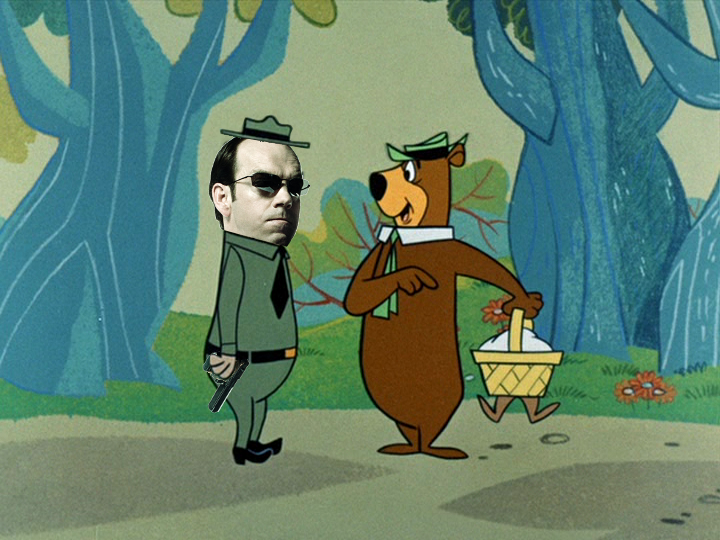
[Other articles in category /misc] permanent link
Tue, 10 Apr 2018
Inconceivable things and non-contingent facts
Philosophy makes a distinguish between necessary and contingent facts, but I'm not exactly sure what it is. I think they would say that the election of Al Gore in 2000 is contingent because it's easy to imagine a universe in which it went the other way and the other guy won. But that seems to depend on our powers of imagination, which doesn't seem very rigorous. Is the mass of the electron necessary or contingent? What about the fine-structure constant?
What facts are necessary? Often in this context people fall back on mathematical truths, for example !!1+1=2!!, which does seem hard to assail. But I recently thought of something even farther down the scale, which seems to me even harder to argue.
Mathematics deals with many sorts of objects which are more or less like the ordinary numbers. Some are more complicated, and ordinary numbers are special cases, for example functions and matrices. Some are simpler, and are special cases themselves. Mathematicians can and do define !!2!! in many different ways. There are mathematical systems with !!1!! and !!+!! in which there is no !!2!!, and instead of !!1+1=2!! we have !!1+1=0!!. Well, not quite; there is !!2!!, but !!2=0!!. So one can say that !!1+1=2!! still, but the !!2!! is not very much like the !!2!! that we usually mean when we say !!1+1=2!!. Anyway certainly there is such a system, and I can certainly conceive of it, so there might be a philosophical argument that could be made that !!1+1=2!! is a contingent fact about how numbers happen to work in the universe in which we happen to find ourselves: we are not living in a universe where numbers form a field of characteristic 2.
But here's a fact that I think is unassailably necessary: rubies are red. Why? By definition! A ruby is a kind of gemstone, a type of aluminum oxide called a corundum, that has a deep red color. There are non-red corundums, but they are sapphires, not rubies, because a ruby is a red corundum. There is no such thing as a blue or a green ruby; a blue or green ruby is not a ruby at all, but a sapphire.
How about over in Narnia, where rubies are blue? Well, maybe the Narnians people call hats “avocadoes”, but whether those things are hats or avocadoes depends not on what the Narnians call them but on their properties. If those things are made of felt and the Narnians wear them on their heads, they are hats, regardless of what the Narnians call them; they are avocadoes only if they are globular and can be eaten on toast. Narnians might put actual avocadoes on their heads and then there might be an argument that these things were hats, but if the avocado is a hat it is only because it is customarily worn on the head.
And so too the Narnians can call !!2!! an avocado and say that !!1+1=\text{avocado}!! but that doesn't mean that !!1+1!! is an avocado, even in Narnia. Maybe the Narnians call avocadoes “rubies”, but they're still avocadoes, not rubies. And maybe the Narnians call blue corundums “rubies”, but they're still sapphires, not rubies, because rubies are red.
So I think it might be conceivable that !!1+1=2!! is contingent, and it's certainly easy to conceive of a universe with no rubies at all, but I can't conceive of any way that a ruby could be other than red.
[Other articles in category /misc/philosophy] permanent link
Thu, 21 Dec 2017
Philadelphians, move to the back of the bus!
I have lived in Philadelphia almost 28 years, and I like it very much. I grew up in New York, and I have some of the typical New Yorker snobbery about the rest of the world, a sort of patronizing “oh, isn't that cute, at least you tried” attitude. This is not a good thing, and I have tried to get rid of it, with only partial success. Philadelphia is not New York and it is never going to be New York, and I am okay with that. When I first got here I was more doubtful, but I made an effort to find and appreciate things about Philadelphia that were better than in New York. There are many, but it took me a while to start noticing them.
In 1992 I wrote an article that began:
Someone asked me once what Philadelphia has that New York doesn't. I couldn't come up with anything good.
But the article explained explained that since then, I had found an excellent answer. I wrote about how I loved the Schuylkill river and how New York had nothing like the it. In Philadelphia you are always going back and forth across the Schuylkill river, sometimes in cars or buses or trains, sometimes on a bike, sometimes on foot. It is not a mighty river like the Hudson. (The Delaware fills that role for us.) The Schuylkill is smaller, but still important. The 1992 article said:
It makes what might otherwise be a static and monolithic entity into a dynamic and variable one. Manhattan is monolithic, like a giant baked potato. Philadelphia is complex inside, with structure and sub-organs, like your heart.
New York has rivers you can cross, but, like much of New York, they are not to human scale. Crossing the Brooklyn Bridge or the George Washington Bridge on foot are fun things to do, once in a while. But they are big productions, a thing you might want to plan ahead, as a special event. Crossing the Schuylkill on foot is something you do all the time. In 1993 I commuted across the Schuylkill on foot twice a day and it was lovely. I took a photograph of it each time, and enjoyed comparing the many looks of the Schuylkill.
Once I found that point of attachment, I started to find many more things about Philadelphia that are better than in New York. Just a few that come to mind:
In New York, if you run into someone you know but had not planned to see, or meet a stranger with whom you have a common acquaintance, you are stunned. It is an epic coincidence, not quite a once-in-a-lifetime kind of thing, but maybe not a once-a-year thing either. In Philadelphia it is still unusual enough to be an interesting and happy surprise but not so rare as to make you wonder if you are being pranked.
In Philadelphia, if you are walking down the street, and say hello to a stranger sitting on their stoop, they will say hello back to you. In New York they will stare at you as though you had just come from the moon, perhaps wondering what your angle is.
If you live in New York, it is preferable to spend all of August in your vacation home, even if it is located on the shore of the lake of boiling pitch in the eighth circle of Hell. The weather is more pleasant in the eighth circle than it is in New York in August, and the air is cleaner. Never in 28 years in Philadelphia have I endured weather that is as bad as New York in August.
This is only a partial list. Philadelphia is superior to New York in many ways, and I left out the most important ones. I am very fond of Philadelphia, which is why I have lived here for 28 years. I can appreciate its good points, and when I encounter its bad points I no longer snarl and say “In New York we knew how to do this right.” Usually.
Usually.
One thing about Philadelphia is seriously broken. Philadelphians do not know how to get on a bus.
Every culture has its own customs. Growing up as a New Yorker, I learned early and deeply a cardinal part of New York's protocol: Get out of the way. Seriously, if you visit New York and you can't get anything else right, at least get out of the way. Here is advice from Nathan Pyle's etiquette guide for newcomers to New York:

Insofar as I still have any authority to speak for New Yorkers, I endorse the advice in this book on their behalf. Quite a lot of it consists of special cases of “get out of the way”. Tip #41 says so in so many words: “Basically anything goes as long as you stay out of the way.” Tip #31 says to take your luggage off the subway seat next to you, and put it on your lap. Tip #65 depicts the correct way of stopping on the sidewalk to enjoy a slice of pizza: immediately adjacent to a piece of street furniture that the foot traffic would have had to have gone around anyway.
Suppose you get on the bus in New York. You will find that the back of the bus is full, and the front is much less so. You are at the front. What do you do now? You move as far back as is reasonably possible — up to the beginning of the full section — so that the next person to get in can do the same. This is (obviously, if you are a New Yorker) the only way to make efficient use of the space and fill up the bus.
In Philadelphia, people do not do this. People get on the bus, move as far back as is easy and convenient, perhaps halfway, or perhaps only a few feet, and then stop, as the mood takes them. And so it often happens that when the bus arrives the new passengers will have to stand in the stepwell, or can't get on at all — even though the bus is only half full. Not only is there standing room in the back, but there are usually seats in the back. The bus abandons people at the stop, because there is no room for them to get on, because there is someone standing halfway down blocking the aisle, and the person just in front of them doesn't want to push past them, and those two people block everyone else.
In New York, the passengers in front would brusquely push their way past these people and perhaps rebuke them. New Yorkers are great snarlers, but Philadelphians seem to be too polite to snarl at strangers. Nobody in Philadelphia says anything, and the space is wasted. People with kids and packages are standing up because people behind them can't be bothered to sit down.
I don't know what the problem is with these people. Wouldn't it easier to move to the back of the bus and to sit down in the empty seats than it is to stand up and block the aisle? I have tried for a quarter of a century to let go of the idea that people in New York are smarter and better and people elsewhere are slow-witted rubes, and I have mostly succeeded. But where Philadelphians are concerned, this bus behavior is a major sticking point.
In New York we knew how to do this right.
[Other articles in category /misc] permanent link
Wed, 07 Jun 2017
Annual self-evaluation time, woo-hoo!
It's annual performance evaluation time at my employer, ZipRecruiter, and as part of that I have to write a self-evaluation. I know many people dread these, and I used to dread them, but these days I like doing it. Instead of being a torture or even a chore, for the last couple of years I have come out of it feeling much better about my job and my performance than I went in.
I think that is about 20% because my company does it in a good way, 30% because it suits my personality, and 50% because I have learned how to handle it well. The first half of that might not help you much, but if you're an evaluation loather, you might be able to transfer some of the second half and make it a little less horrible for yourself.
How ZipRecruiter does self-evaluations
I will get this out of the way because it's quick. ZipRecruiter does these evaluations in a way that works well for me. They do not pester me with a million questions. They ask only four, which are roughly:
- What were your main accomplishments this year?
- Describe areas you feel require improvement.
- What do you hope to accomplish in the coming year?
- How can your manager help you?
I very much appreciate this minimalist approach. It gets right to the point, covers all the important issues and nothing more. None of these questions feels to me like a meaningless bureaucratism or a waste of time.
Answering the questions thoroughly takes (only) two or three hours, but would take less if I didn't write such detailed answers; I'm sure I could write an acceptable report in an hour. I can see going in that it will be a finite process.
Why this suits my personality well
If you have followed this blog for a while, you may have noticed that I like writing essays, particularly essays about things I have been working on or thinking about. ZipRecruiter's self-evaluation process invites me to write a blog post about my year's work. This is not everyone's cup of tea, but it is right up my alley. Tea alley. Hee hee.
My brain has problems
My big problems with writing a self-evaluation are first, that I have a very poor memory, and second, that I think of myself as a lazy slacker who spends a lot of time goofing off and who accomplishes very little. These combine badly at evaluation time.
In the past, I would try to remember what work I did in the previous year so I could write it up. My memory is poor, so I wouldn't remember most of what I had done, and then it was easy to come to the conclusion that I had not done very much, probably because I was a lazy slacker whose spent a lot of time goofing off. I would go through several iterations of this, until, tormented by guilt and self-hatred, I would write that into the self-evaluation. This is not a practice I would recommend.
If there were two projects, A and B, and I promptly finished A but B dragged on and was running late, which one would I be more likely to remember when the time came to write the self-evaluation report? B, of course. It was still on my mind because I spent so long thinking about it and because it was still in progress. But I had forgotten about A immediately after putting it to rest. Since I could remember only the unfinished projects, I would conclude that I was a lazy slacker who never finished anything, and write that into the self-evaluation. This is also a a practice I recommend you avoid.
The ticketing system is my bionic brain
The way I have been able to escape this horrible trap is by tracking every piece of work I do, every piece, as a ticket in our ticketing system. People often come to me and ask me to do stuff for them, and I either write up a ticket or I say “sure, write me a ticket”. If they ask why I insist on the ticket (they usually don't), I say it's because when self-evaluation time comes around I want to be able to take credit for working on their problem. Everyone seems to find this reasonable.
Then, when it's time to write the self-evaluation, the first thing I do is visit the ticket website, select all my tickets from the past year, and sort them into chronological order. I look over the list of ticket titles and make a list of stuff that might be worth mentioning on the evaluation. I will have forgotten about three-fourths of it. If I didn't have the list in the ticketing system, I would only remember the most recent one-fourth and conclude that I spent three-fourths of my time goofing off because I am a lazy slacker. Instead, there is this long list of the year's accomplishments, too many to actually include in the report.
Well, this is not rocket science. One is called upon to describe the year's accomplishments. Even people with better memory than me surely cannot remember all this without keeping records, can they? Anyway I surely cannot, so I must keep records and then consult them when the time comes. Put that way, it seems obvious. Why did it take so long to figure out? But there are a lot of happy little details that were not so obvious.
Instead of thinking “Why didn't I finish big project X? I must have been goofing off. What a lazy slacker I am” I think “holy cow, I resolved 67 tickets related to big project X! That is great progress! No wonder I got hardly anything else done last fall” and also “holy cow, X has 78 resolved tickets and 23 still open. It is huge! No wonder it is not finished yet.”
Writing “I completed 67 tickets related to X” is a lot more concrete than “I worked hard on X”. If you are neurotic in the way I am, and concerned that you might be a lazy slacker, it feels much more persuasive. I have an idea that it sounds better to my boss also, particularly if he were to be called upon to discuss it with his manager. (“Under my leadership, Mark completed 67 tickets related to X!”) Andy Lester says that your job is to make your boss happy, and that means making it easy for him to do his job, which is to make his boss happy. So this is no small thing.
Instead of thinking “Gee, the CTO declared top priority initiative Y, and while everyone else was working hard on it I mostly ignored it because I am a lazy slacker” I might see that I have tagged 9 tickets “top priority initiative Y”. Then on the report, I proudly boast “I completed 9 tickets in support of the CTO's mandate, including (most important one) and (most impressive one).” This also comes under the heading of “make it easy for your boss to do his job”.
Instead of completely forgetting that I did project Z, I see the tickets and can put it in my report.
Instead of remembering awful project W, which dragged on for months, and thinking what a lazy slacker I was because I couldn't get it done, I have a progress record in the ticket and the details might suggest a different interpretation: Project W sucked, but I nevertheless pursued it doggedly to completion, even though it took months.
I might remember that I once helped Jones, but what did I help him with? Did I really spend much time on him? Without looking at the ticket list, I might not realize that I helped Jones every few weeks all year long. This sort of pattern is often apparent only in the retrospective summary. With the ticket system, instead of “oh, Jones sometimes asks me questions, I guess” I can see that supporting Jones was an ongoing thing and he kept coming back. This goes into the report: “I provided ongoing support to Jones, including (some cherry-picked example that makes me look especially good).”
One question (#2) on the report form is “Describe areas you feel require improvement”. If I wrote in last year's report that I would like to improve at doing X, I can look in the ticket system for specific evidence that I might have improved, even if I wasn't consciously trying to improve X at the time. Probably there is something somewhere that can at least be spun as an attempt to improve at X. And if it didn't actually improve X, I can still ask myself why it didn't and what might work instead, and put that in the report as something to try next time, which is question #3.
Hey, look at that, I am evaluating my prior performance and making informed corrections. That might be a useful practice. Wouldn't it be great if I took time every so often to do that? Some sort of periodic self-evaluation perhaps?
Another question (#3) is “What would you like to do in the coming year?” If I wrote in last year's report said “I would like to do more of X” I can look for evidence that I did do that, and then write it into this year's report: “Last year I said I would try to do more of X, and I did.”
Even if I were having a bad year and got very little done—and this has happened—having a list of the stuff I did get done leaves me in a much better position to write the report than not having such a list.
None of this good stuff would be possible without an actual record of what I did. If there weren't a ticketing system, I would have to invent one or maybe tattoo it on my chest like the guy in Memento. Even aside from its use in writing annual self-evaluations, keeping a work diary is crucial for me, because without it I can't remember day-to-day what I am working on and what needs to happen next. And even for people with better memory than me, are they really going to remember all 317 things they did for work this year, or that 67 of them pertained to big project X? If they can that's great but I doubt it.
Keeping a work record is part of my job
I think it is important to maintain the correct attitude to this. It would be easy to imagine ticket management as unproductive time that I wasted instead of accomplishing something useful. This is wrong. The correct attitude is to consider ticket updates to be part of my work product: I produce code. I produce bug fixes. I produce documentation, reports, and support interactions. And I also produce ticket updates. This is part of my job and while I am doing it I am not goofing off, I am not procrastinating, I am doing my job and earning my salary. If I spent the whole day doing nothing but updating tickets, that would be a day well-spent.
Compare “I produce ticket updates” with “I produce unit tests”. The attitude for ticket updates is the same as for testing. When something happens in a project, I update the ticket, because keeping the tickets updated is part of the project, just like writing tests is. An organization that fails to support ticket updates is broken in the same way as one that fails to support test development.
My boss gets email every time I update a ticket. I don't know if he reads these, but he has the option to, and I don't need to worry as much that maybe he thinks I am a lazy slacker who is goofing off, because he is getting a stream of automatic notifications about what I am up to. I'm not my boss but if I were I would appreciate this very much.
Maybe some of this can help you?
There might be some use in this even for people who aren't already in the habit of writing self-absorbed blog posts.
If doing the annual self-evaluation makes you suffer, maybe it would help to practice writing some blog posts. You don't have to publish them or show anyone. Next time you finish a project, set aside thirty or sixty minutes to try to write up a little project report: What worked, what didn't, what are you pleased about, what was surprising, what was fun, what was annoying? I'm not certain this will help but it seems like this is a skill that might get easier with practice, and then when you have to write your annual self-evaluation it might be easier because you have more practice doing it. Also, you would have a little file of material to draw on and would not have to start from zero.
If your employer's process requires you to fill in some giant questionnaire, it might be easier to do if you go into it with answers to the four basic questions prepared ahead of time. (I imagine that it's even possible that if you address the four big questions and ignore everything on the giant questionnaire that doesn't pertain to them, everyone will be perfectly satisfied and nobody will notice the omissions.)
And keep a work diary! Tattoo it on your chest if you have to. If it seems daunting, realize that you don't have to do it all at once. Keeping a work diary of some sort is forgiving in the same way as writing unit tests:
It's not all-or-nothing, you don't have to test every piece of code to get any benefit from testing. If you write tests for 1% of the code, you get about 1% of the benefit, and you can ramp up.
If you break your test-writing streak you don't have to start over from zero. If you didn't write any tests for the code you wrote last week, that's a shame, but it doesn't affect the benefit you can get from writing a unit test for whatever you're working on today.
The work diary is similar. When time comes to write your evaluation, a small and incomplete record is better than no record at all. If you forget to write in the diary for a month, that's a shame, but it doesn't affect the benefit you can get from writing down today what you did today.
Our ticketing system
This isn't important, but I expect someone will want to know: At work we use FogBugz. Some of my co-workers dislike it but I have no major complaints. If you want to try it on your own, they have a seven-day free trial offer, after which you can sign up for a permanent free account that supports up to two users. I am experimenting with using a free tier account to manage my personal to-do list.
Coming soon
I wrote another 2,000 words about my specific practices for managing tickets. I hope it'll be along in a few days.
[ Addendum 20190701: Julia Evans has written an article on the same topic, but with more details, useful suggestions I hadn't thought of, and also without all the neurosis.
I don't know why I haven't published my promised article on ticket management. (“Coming soon”, ha ha.) It looks pretty good. Later this week, maybe? ]
[Other articles in category /misc] permanent link
Mon, 08 May 2017
An anagrammatic cautionary tale

I previously claimed that “cinematographer” / “megachiropteran” was the best anagram in English. Scoring all the anagrams in the list of 13 million Wikipedia article titles did not refute this, but it did reveal that “cinematographer” is also an anagram of “Taichang Emperor”.
The Taichang Emperor (泰昌) lived from 1582 to 1620 and was the 14th emperor of the Ming Dynasty. His reign as emperor lasted only 29 days, after which he died of severe diarrhea. Wikipedia says:
According to non-official primary sources, the Taichang Emperor's illness was brought about by excessive sexual indulgence after he was presented with eight maidens by Lady Zheng.
To counteract the diarrhea, the emperor took a “red pill” offered to him by a court official:
It was recorded in official Ming histories that the Taichang Emperor felt much better after taking the red pill, regained his appetite and repeatedly praised Li Kezhuo as a "loyal subject". That same afternoon, the emperor took a second pill and was found dead the next morning.
Surely this tale of Ming China has something to teach us even today.
[Other articles in category /misc] permanent link
Tue, 31 Jan 2017Below, One Liberty Place, the second-tallest building in my home city of Philadelphia. (Completed 1987, height 288 meters.)
Below, Zhongtian International Mansion at Fortune Plaza, the tallest building in Ürümqi, capital city of Xinjiang in northwest China.
(Completed 2007, height 230 meters.)
[ Addendum: Perhaps I should mention that One Liberty Place is itself widely seen as a knockoff of the much more graceful and elegant Chrysler Building in New York City. (Completed 1930, height 319 meters.) ]
[ Addendum: I brought this to the attention of GroJLart, the foulmouthed architecture blogger who knows everything, absolutely everything, about Philadelphia buildings, and he said “Thanks. I wrote an article on the same subject in 2011”. Of course. ]
[Other articles in category /misc] permanent link
Mon, 11 Apr 2016Recently the following amusing item was going around on Twitter:
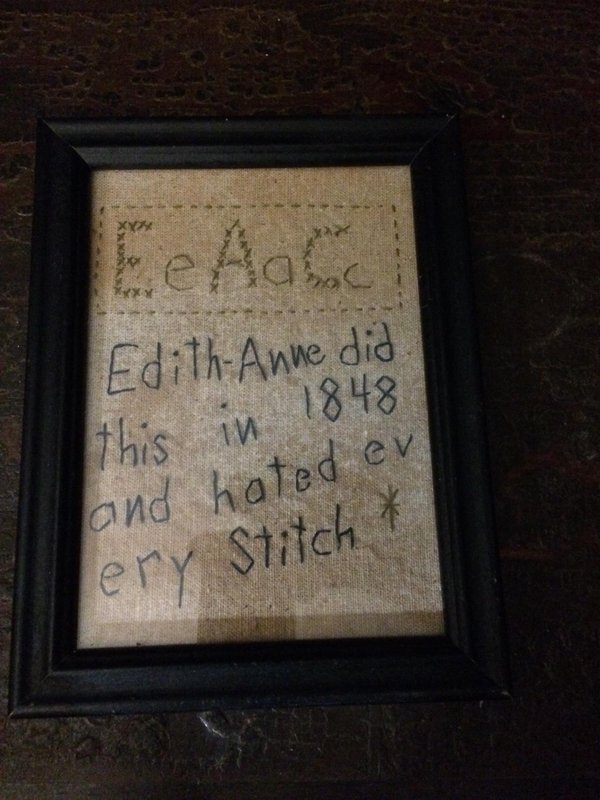
I have some bad news and some good news. First the good news: there is an Edith-Anne. Her name is actually Patty Polk, and she lived in Maryland around 1800.
Now the bad news: the image above is almost certainly fake. It may be a purely digital fabrication (from whole cloth, ha ha), or more likely, I think, it is a real physical object, but of recent manufacture.
I wouldn't waste blog space just to crap on this harmless bit of fake history. I want to give credit where it is due, to Patty Polk who really did do this, probably with much greater proficiency.
Why I think it's fake
I have not looked into this closely, because I don't think the question merits a lot of effort. But I have two reasons for thinking so.
The main one is that the complaint “Edith-Anne … hated every Stitch” would have taken at least as much time and effort as the rest of the sampler, probably more. I find it unlikely that Edith-Anne would have put so much work—so many more hated stitches—into her rejection.
Also, the work is implausibly poor. These samplers were stitched by girls typically between the ages of 7 and 14, and their artisanship was much, much better than either section of this example. Here is a sampler made by Lydia Stocker in 1798 at the age of 12:

Here's one by Louisa Gauffreau, age 8:
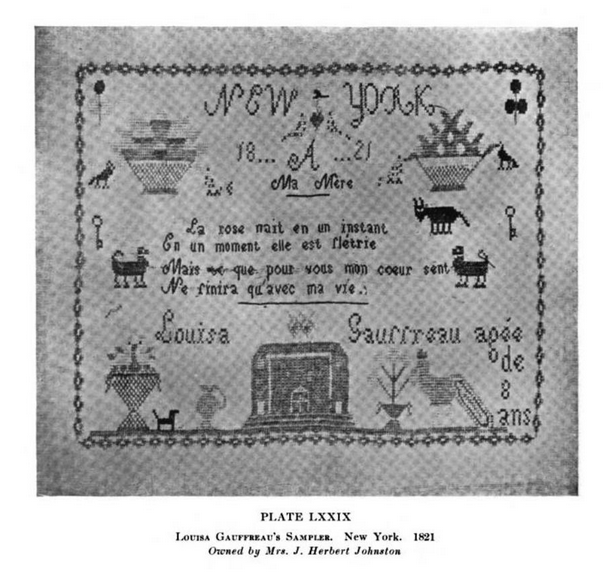
 Compare these
with Edith-Anne's purported cross-stitching. One tries to imagine how
old she is, but there seems to be no good answer. The crooked
stitching is the work of a very young girl, perhaps five or six. But
the determination behind the sentiment, and the perseverance that
would have been needed to see it through, belong to a much older girl.
Compare these
with Edith-Anne's purported cross-stitching. One tries to imagine how
old she is, but there seems to be no good answer. The crooked
stitching is the work of a very young girl, perhaps five or six. But
the determination behind the sentiment, and the perseverance that
would have been needed to see it through, belong to a much older girl.
Of course one wouldn't expect Edith-Anne to do good work on her hated sampler. But look at the sampler at right, wrought by a young Emily Dickinson, who is believed to have disliked the work and to have intentionally done it poorly. Even compared with this, Edith-Anne's claimed sampler doesn't look like a real sampler.
Patty Polk
Web search for “hated every stitch” turns up several other versions of Edith-Anne, often named Polly Cook1 or Mary Pitt2 (“This was done by Mary Pitt / Who hated every stitch of it”) but without any reliable source.
However, Patty Polk is reliably sourced. Bolton and Coe's American Samplers3 describes Miss Polk's sampler:
POLK, PATTY. [Cir. 1800. Kent County, Md.] 10 yrs. 16"×16". Stem-stitch. Large garland of pinks, roses, passion flowers, nasturtiums, and green leaves; in center, a white tomb with “G W” on it, surrounded by forget-me-nots. “Patty Polk did this and she hated every stitch she did in it. She loves to read much more.”
The description was provided by Mrs. Frederic Tyson, who presumably owned or had at least seen the sampler. Unfortunately, there is no picture. The “G W” is believed to refer to George Washington, who died in 1799.
There is a lively market in designs for pseudo-vintage samplers that you can embroider yourself and “age”. One that features Patty Polk was produced by Falling Star Primitives:
Thanks to Lee Morrison of Falling Star Primitives for permission to use her “Patty Polk” design.
References
1. Parker, Rozsika. The Subversive Stitch: Embroidery and the Making of the Feminine. Routledge, 1989. p. 132.
2. Wilson, Erica. Needleplay. Scribner, 1975. p. 67.
3. Bolton, Ethel Stanwood and Eva Johnston Coe. American Samplers. Massachusetts Society of the Colonial Dames of America, 1921. p. 210.
[ Thanks to several Twitter users for suggesting gender-neutral vocabulary. ]
[ Addendum: Twitter user Kathryn Allen observes that Edith-Anne hated cross-stitch so much that she made another sampler to sell on eBay. Case closed. ]
[ Addendum: Ms. Allen further points out that the report by Mrs. Tyson in American Samplers may not be reliable, and directs me to the discussion by J.L. Bell, Clues to a Lost Sampler. ]
[ Addendum 20160619: Edith-Anne strikes again!. For someone who hated sewing, she sure did make a lot of these things. ]
[ Addendum 20200801: More about this by Emily Wells, who cites an earlier Twitter thread by fashion historian Hilary Davidson that makes the same points I did: “no matter how terribly you sewed in 1877, it would have been impossible to sew badly like this for a middle-class sampler”. ]
[ Addendum 20211011: Ms. Wells’ article also explains the connection between Patty Polk and Mrs. Tyson, who I said “presumably owned or had at least seen the sampler.”:
Patty Polk was Martha E. Polk, the daughter of Joseph Polk and Margaret Durborough. Born on March 2, 1817, Polk likely completed her needlework picture at some point in the 1830s. In 1921, Polk’s daughter, Florence McIntyre Tyson, submitted her mother’s sampler for inclusion in Bolton and Coe’s American Samplers.
]
[Other articles in category /misc] permanent link
Mon, 22 Jun 2015In late April I served a residency at Recurse Center, formerly known as Hacker School. I want to write up what I did before I forget.
Recurse Center bills itself as being like a writer's retreat, but for programming. Recursers get better at programming four days a week for three months. There are some full-time instructors there to help, and periodically a resident, usually someone notable, shows up for a week. It's free to students: RC partners with companies that then pay it a fee if they hire a Recurser.
I got onto the RC chat system and BBS a few weeks ahead and immediately realized that it was going to be great. I am really wary about belonging to groups, but I felt like I fit right in at RC, in a way that I hadn't felt since I went off to math camp at age 14. Recurse Center isn't that different from math camp now that I think about it.
The only prescribed duty of a resident is to give a half-hour talk on Monday night, preferably on a technical topic. I gave mine on the history and internals of lightweight hash structures in programming languages like Python and Perl. (You can read all about that if you want to.)
Here's what else I did:
I gave a bunch of other talks: two on Git, one on calculating with continued fractions, one on how the Haskell type inferencer works, one on the topology of data types, one on the Unix process model, one on Alien Horrors from the Dawn of Unix. This was too many talks. I didn't have enough energy and time to prepare all of them properly. On the other hand, a lot of people were very complimentary about the talks and said they were very glad that I gave so many. Also, giving talks is a great way to get people familiar with you so that they won't be shy about talking to you or asking you to work with them. But I think I'll cut it down to one per day next time.
Alex Taipale was inspired by my hash talk to implement hashes synthetically in Python, and I paired with her on that for the first part and reviewed her code a couple of times after. It was really fun to see how she went about it.
Libby Horacek showed me around the text adventure game she wrote in Haskell. I had the first of several strokes of luck here. Libby had defined an input format to specify the room layout and the objects, and I observed that it was very similar to Asherah, a project that another Recurser, Michelle Steigerwalt, had done a couple of years before. I found this out because I read everyone's self-posted bio ahead of time and browsed the interesting-sounding links.
Aditya Mukerjee was implementing Git in Go. He wanted help deciphering the delta format. Later I paired with Aditya again and we debugged his implementation of the code that expanded the deltas back into complete files. I hadn't known any Go but it's easy to pick up.
Geoffrey Gilmore had read my ancient article on how to write a regex matcher. He had written his own implementation in Scala and wanted to show it to me. I didn't know any Scala but the code was very clear. Geoffrey had worked out a clever way to visualize the resulting finite automaton: his automaton object had a method that would dump out its graph in the "dot" language, and he could feed that to Graphviz to get it to draw the graph.
I had a conference with Ahmed Abdalla and Joel Burget about SML. The main question they wanted me to answer: Why might they want to look at SML instead of Haskell? This was a stroke of luck: I was unusually well-prepared to answer this question, having written many thousands of lines of SML since about 1993. My answer was unequivocally that there was no reason, SML was obsolete, because it had big problems which had never been solved, and Haskell had been introduced in part to solve, avoid, or finesse these problems.
For example, nobody knows how to incorporate references into a Hindley-Milner type system. SML has tried at least three methods for doing this over the years. They all suck, and none of them work right. Haskell avoids the whole issue: no references. If you want something like references, you can build a monad that simulates it locally.
I could probably write a whole blog article about this, so maybe another time.
[ Addendum 20220425: The article is written! ]
Libby wanted to pair with me again. She offered me a choice: she was building an e-reader, controlled by a Raspberry Pi, and mounted inside an antique book that she had hollowed out. I would have been willing to try this, although I didn't know anything about Raspberry Pi. But my other choice was very attractive: she was reviving KiSS, an ancient Windows paper-doll app that had been current in the 1990s. people had designed hundreds or thousands of dolls and costumes, which were all languishing because nobody wanted to run the app any more. She wanted to reimplement the dress-up program in Javascript, and port the doll and clothing cels to PNG files. Here I had another stroke of luck. I was already familiar with the program, and I think I have even been into its source code at some point.
Libby had found that Gimp could load a KiSS cel, so we looked at the Gimp source code to figure out the file format. She had been planning to use
libpngto turn the cel into a PNG, but I showed her a better way: convert it into a PPM file and feed to toppmtopng. This saved a lot of trouble! (I have written a little bit about this approach in the past.) Libby hacked in the Gimp code, grafting her PPM file writing code into the Gimp cel reading code in place of Gimp's internal pixmap operations. It worked!I talked to Chris Ball about his GitTorrent project. Chris wants to make a decentralized github that doesn't depend on the GitHub company or on their technical infrastructure. He spent a long time trying to make me understand why he wanted to do the project at all and what it was for. I think I eventually got it. It also transpired that Chris knows way more about BitTorrent than I do. I don't think I was much help to Chris.
Jesse Chen paired with me to fix the layout problems that have been troubling my blog for years. We redid the ancient table-based layout that I had inherited from Blosxom ten years ago, converting it mostly to CSS, and fixed a bunch of scrolling problems. We also fixed it to be legible on a phone display, which it previously wasn't. Thanks Jesse!
I had a discussion with Michelle Steigerwalt about big-O notation and how you figure out what an algorithm's big-O-ness is, either from counting lines in the source code or the pseudocode, or from running the algorithm on different-size inputs and timing it. It's fun that you can do the static analysis and then run the program and see it produce the results you predicted.
There was a lot of other stuff. I met or at least spoke with around 90% of the seventy or so Recursers who were there with me. I attended the daily stand-up status meetings with a different group each time. I ate lunch and dinner with many people and had many conversations. I went out drinking with Recursers at least once. The RC principals kindly rescheduled the usual Thursday lightning talks to Monday so I could attend. I met Erik Osheim for lunch one day. And I baked cookies for our cookie-decorating party!
It was a great time, definitely a high point in my life. A thousand thanks to RC, to Rachel Vincent and Dave Albert for essential support while I was there, and to the facilitators, principals, and especially to the other Recursers.
[Other articles in category /misc] permanent link
Wed, 01 Apr 2015
Your kids will love a cookie-decorating party
We had a party last week for Toph's 7th birthday, at an indoor rock-climbing gym, same as last year. Last year at least two of the guests showed up and didn't want to climb, so Lorrie asked me to help think of something for them to do if the same thing happened this year. After thinking about it, I decided we should have cookie decorating.
This is easy to set up and kids love it. I baked some plain sugar cookies, bought chocolate, vanilla, and strawberry frosting, several tubes of edible gel, and I mixed up five kinds of colored sugar. We had some colored sprinkles and little gold dragées and things like that. I laid the ingredients out on the table in the gym's side room with some plastic knives and paintbrushes, and the kids who didn't want to climb, or who wanted a break from climbing, decorated cookies. It was a great success. Toph's older sister Katara had hurt her leg, and couldn't climb, so she helped the littler kids with cookies. Even the tiny two-year-old sister of one of the guests was able to participate, and enjoyed playing with the dragées.
(It's easy to vary the project depending on how much trouble you want to take. I made the cookies from scratch, which is pretty easy, but realized later I could have bought prefabricated cookie batter, which would have been even easier. The store sold colored sugar for $3.29 for four ounces, which is offensive, so I went home and made my own. You put one drop of food coloring per two ounces of sugar in a sealed container and shake it up for a minute, for a total cost of close to zero; Toph helped with this. I bought my frosting, but when my grandmother used to do it she'd make a simple white frosting from confectioners' sugar and then color it with food coloring.)
I was really pleased with the outcome, and not just because the guests liked it, but also because it is a violation of gender norms for a man to plan a cookie-decorating activity and then bake the cookies and prepare the pastel-colored sugar and so forth. (And of course I decorated some cookies myself.) These gender norms are insidious and pervasive, and to my mind no opportunity to interfere with them should be wasted. Messing with the gender norms is setting a good example for the kids and a good example for other dads and for the rest of the world.
I am bisexual, and sometimes I feel that it doesn't affect my life very much. The sexual part is mostly irrelevant now; I fell in love with a woman twenty years ago and married her and now we have kids. I probably won't ever have sex with another man. Whatever! In life you make choices. My life could have swung another way, but it didn't.
But there's one part of being bisexual that has never stopped paying dividends for me, and that is that when I came out as queer, it suddenly became apparent to me that I had abandoned the entire gigantic structure of how men are supposed to behave. And good riddance! This structure belongs in the trash; it completely sucks. So many straight men spend a huge amount of time terrified that other straight men will mock them for being insufficiently manly, or mocking other straight men for not being sufficiently manly. They're constantly wondering "if I do this will the other guys think it's gay?" But I've already ceded that argument. The horse is out of the barn, and I don't have to think about it any more. If people think what I'm doing is gay, that's a pill I swallowed when I came out in 1984. If they say I'm acting gay I'll say "close, but actually, I'm bi, and go choke on a bag of eels, jackass."
You don't have to be queer to opt out of straight-guy bullshit, and I think I would eventually have done it anyway, but being queer made opting out unavoidable. When I was first figuring out being queer I spent a lot of time rethinking my relationship to society and its gender constructions, and I felt that I was going to have to construct my own gender from now and that I no longer had the option of taking the default. I wasn't ever going to follow Rule Number One of Being a Man (“do not under any circumstances touch, look at, mention, or think about any dick other than your own”), so what rules was I going to follow? Whenever someone tried to pull “men don't” on me, (or whenever I tried to pull it on myself) I'd immediately think of all the Rule Number One stuff I did that “men don't” and it would all go in the same trash bin. Where (did I say this already?) it belongs.
Opting out frees up a lot of mental energy that I might otherwise waste worrying about what other people think of stuff that is none of their business, leaving me more space to think about how I feel about it and whether I think it's morally or ethically right and whether it's what I want. It means that if someone is puzzled or startled by my pink sneakers, I don't have to care, except I might congratulate myself a little for making them think about gender construction for a moment. Or the same if people find out I have a favorite flower (CROCUSES YEAH!) or if I wash the dishes or if I play with my daughters or watch the ‘wrong’ TV programs or cry or apologize for something I did wrong or whatever bullshit they're uncomfortable about this time.
Opting out frees me up to be a feminist; I don't have to worry that a bunch of men think I'm betraying The Team, because I was never on their lousy team in the first place.
And it frees me up to bake cookies for my kid's birthday party, to make a lot of little kids happy, and to know that that can only add to, not subtract from, my identity. I'm Dominus, who loves programming and mathematics and practicing the piano and playing with toy octopuses and decorating cookies with a bunch of delightful girls.
This doesn't have to be a big deal. Nobody is likely to be shocked or even much startled by Dad baking cookies. But these tiny actions, chipping away at these vile rules, are one way we take tiny steps toward a better world. Every kid at that party will know, if they didn't before, that men can and do decorate cookies.
And perhaps I can give someone else courage to ignore some of that same bullshit that prevents all of us from being as great as we could and should be, all those rules about stuff men aren't supposed to do and other stuff women aren't supposed to do, that make everyone less. I decided about twenty years ago that that was the best reason for coming out at all. People are afraid to be different. If I can be different, maybe I can give other people courage and comfort when they need to be different too. As a smart guy once said, you can be a light to the world, like a city on a hilltop that cannot be hidden.
And to anyone who doesn't like it, I say:
[Other articles in category /misc] permanent link
Sat, 19 Jul 2014
Similarity analysis of quilt blocks
As I've discussed elsewhere, I once wrote a program to enumerate all
the possible quilt blocks of a certain type. The quilt blocks in
question are, in quilt jargon, sixteen-patch half-square triangles. A
half-square triangle, also called a “patch”, is two triangles of fabric sewn together, like
this: 
Then you sew four of these patches into a four-patch, say like this:

Then to make a sixteen-patch block of the type I was considering, you take four identical four-patch blocks, and sew them together with rotational symmetry, like this:

It turns out that there are exactly 72 different ways to do this. (Blocks equivalent under a reflection are considered the same, as are blocks obtained by exchanging the roles of black and white, which are merely stand-ins for arbitrary colors to be chosen later.) Here is the complete set of 72:








































































It's immediately clear that some of these resemble one another, sometimes so strongly that it can be hard to tell how they differ, while others are very distinctive and unique-seeming. I wanted to make the computer classify the blocks on the basis of similarity.
My idea was to try to find a way to get the computer to notice which
blocks have distinctive components of one color. For example, many
blocks have a distinctive diamond shape  in the center.
in the center.
Some have a pinwheel like this:

which also has the diamond in the middle, while others have a different kind of pinwheel with no diamond:

I wanted to enumerate such components and ask the computer to list which blocks contained which shapes; then group them by similarity, the idea being that that blocks with the same distinctive components are similar.
The program suite uses a compact notation of blocks and of shapes that makes it easy to figure out which blocks contain which distinctive components.
Since each block is made of four identical four-patches, it's enough just to examine the four-patches. Each of the half-square triangle patches can be oriented in two ways:


Here are two of the 12 ways to orient the patches in a four-patch:


Each 16-patch is made of four four-patches, and you must imagine that the
four-patches shown above are in the upper-left position in the
16-patch. Then symmetry of the 16-patch block means that triangles with the
same label are in positions that are symmetric with respect to the
entire block. For example, the two triangles labeled b are on
opposite sides of the block's northwest-southeast diagonal. But there
is no symmetry of the full 16-patch block that carries triangle d to
triangle g, because d is on the edge of the block, while g is in the interior.
Triangles must be colored opposite colors if they are part of the same patch, but other than that there are no constraints on the coloring.
A block might, of course, have patches in both orientations:

All the blocks with diagonals oriented this way are assigned
descriptors made from the letters bbdefgii.
Once you have chosen one of the 12 ways to orient the diagonals in the
four-patch, you still have to color the patches. A descriptor like
bbeeffii describes the orientation of the diagonal lines in the
squares, but it does not describe the way the four patches are
colored; there are between 4 and 8 ways to color each sort of
four-patch. For example, the bbeeffii four-patch shown earlier can be colored in six different ways:







In each case, all four diagonals run from northwest to southeast. (All other ways of coloring this four-patch are equivalent to one of these under one or more of rotation, reflection, and exchange of black and white.)
We can describe a patch by listing the descriptors of the eight triangles, grouped by which triangles form connected regions. For example, the first block above is:


b/bf/ee/fi/i
because there's an isolated white b triangle, then a black parallelogram
made of a b and an f patch, then a white triangle made from the
two white e triangles, then another parallelogram made from the black f
and i, and finally in the middle, the white i. (The two white e
triangles appear to be separated, but when four of these four-patches are
joined into a 16-patch block, the two white e patches will be
adjacent and will form a single large triangle:  )
)
The other five bbeeffii four-patches are, in the same order they are shown above:
b/b/e/e/f/f/i/i
b/b/e/e/fi/fi
b/bfi/ee/f/i
bfi/bfi/e/e
bf/bf/e/e/i/i
All six have bbeeffii, but grouped differently depending on the
colorings. The second one (
b/b/e/e/f/f/i/i) has no regions with
more than one triangle; the fifth (
bfi/bfi/e/e) has two large regions of three triangles each, and two
isolated triangles. In the latter four-patch, the bfi in the
descriptor has three letters because the patch has a corresponding
distinctive component made of three triangles.
I made up a list of the descriptors for all 72 blocks; I think I did
this by hand. (The work directory contains a blocks
file that maps
blocks to their descriptors, but the
Makefile does
not say how to build it, suggesting that it was not automatically
built.) From this list one can automatically
extract a
list of descriptors of interesting
shapes: an
interesting shape is two or more letters that appear together in some
descriptor. (Or it can be the single letter j, which is
exceptional; see below.) For example, bffh represents a distinctive
component. It can only occur in a patch that has a b, two fs, and
an h, like this one:

and it will only be significant if the b, the two fs, and the h are
the same color:

in which case you get this distinctive and interesting-looking hook component.
There is only one block that includes this distinctive hook component;
it has descriptor b/bffh/ee/j, and looks like this:  . But some of the distinctive
components are more common. The
. But some of the distinctive
components are more common. The ee component represents the large white half-diamonds on the four sides.
A block with "ee" in its descriptor always looks like this:

and the blocks formed from such patches always have a distinctive half-diamond component on each edge, like this:

(The stippled areas vary from block to block, but the blocks with ee
in their descriptors always have the half-diamonds as shown.)
The blocks listed at http://hop.perl.plover.com/quilt/analysis/images/ee.html
all have the ee component. There are many differences between them, but
they all have the half-diamonds in common.
Other distinctive components have similar short descriptors. The two pinwheels I
mentioned above are

gh and

fi, respectively; if you look at
the list of gh blocks
and
the list of fi blocks
you'll see all the blocks with each kind of pinwheel.
Descriptor j is an exception. It makes an interesting shape all by itself,
because any block whose patches have j in their descriptor will have
a distinctive-looking diamond component in the center. The four-patch looks like
this:

so the full sixteen-patch looks like this:

where the stippled parts can vary. A look at the list of blocks with
component
j will
confirm that they all have this basic similarity.
I had made a list of the descriptors for each of the 72 blocks, and from this I extracted a list of the descriptors for interesting component shapes. Then it was only a matter of finding the component descriptors in the block descriptors to know which blocks contained which components; if the two blocks share two different distinctive components, they probably look somewhat similar.
Then I sorted the blocks into groups, where two blocks were in the same group if they shared two distinctive components. The resulting grouping lists, for each block, which other blocks have at least two shapes in common with it. Such blocks do indeed tend to look quite similar.
This strategy was actually the second thing I tried; the first thing didn't work out well. (I forget just what it was, but I think it involved finding polygons in each block that had white inside and black outside, or vice versa.) I was satisfied enough with this second attempt that I considered the project a success and stopped work on it.
The complete final results were:
- This tabulation of blocks that are somewhat similar
- This tabulation of blocks that are distinctly similar (This is the final product; I consider this a sufficiently definitive listing of “similar blocks”.)
- This tabulation of blocks that are extremely similar
And these tabulations of all the blocks with various distinctive components: bd bf bfh bfi cd cdd cdf cf cfi ee eg egh egi fgh fh fi gg ggh ggi gh gi j
It may also be interesting to browse the work directory.
[Other articles in category /misc] permanent link
Mon, 23 Dec 2013Every week one of the founders of my company sends around a miscellaneous question, and collates the answers, which are shared with everyone on Monday. This week the question was “What's the best advice you've ever heard?”
My first draft went like this:
When I was a freshman in college, I skipped a bunch of physics labs that were part of my physics grade. Toward the end of the semester, with grades looming, I began to regret this and went to the TA, to ask if I could do them anyway. He took me to see the lab director, whose permission was required.
The lab director asked why I'd missed the labs the first time around. I said, truthfully, that I had no good excuse.
As soon as I had left the room with the TA, he turned to me and whispered fiercely “You should have lied!”
That advice is probably very good, and I am very bad at taking it. I should have written a heartwarming little homily about how my uncle always told me always to always look for the good in people's hearts, or something uplifting like that.
So here I am, not taking that TA's advice, again.
I thought about that for a while and wondered if I could think of anything else to write down. I added:
If you don't like “You should have lied!”, I offer instead “Nothing is often a good thing to do, and always a clever thing to say.”
I thought about that for a while and decided that nothing was a much cleverer thing to say, and I had better take my own advice. So I scrubbed it all out.
I did finally find a good answer. I told everyone that when I was fifteen, my cousin Alex, who is a chemistry professor, told me never to go anywhere without a pen and paper. That may actually be the best advice I have ever received, and I do think it beats out the TA's.
[Other articles in category /misc] permanent link
Fri, 10 Feb 2012
I abandon my abusive relationship with Facebook
I have just deactivated my Facebook account, I hope for good.
This interview with Eben Moglen provides many of the reasons, and was probably as responsible as anything for my decision.
But the straw that broke the camel's back was a tiny one. What finally pushed me over the edge was this: "People who can see your info can bring it with them when they use apps.". This time, that meant that when women posted reviews of men they had dated on a dating review site, the review site was able to copy the men's pictures from Facebook to insert into the reviews. Which probably was not what the men had in mind when they first posted those pictures to Facebook.
This was, for me, just a little thing. But it was the last straw because when I read Facebook's explanation of why this was, or wasn't, counter to their policy, I realized that with Facebook, you cannot tell the difference.
For any particular appalling breach of personal privacy you can never guess whether it was something that they will defend (and then do again), or something that they will apologize for (and then do again anyway). The repeated fuckups for which they are constantly apologizing are indistinguishable from their business model.
So I went to abandon my account, and there was a form they wanted me to fill out to explain why: "Reason for leaving (Required)": One choice was "I have a privacy concern.":

Please remember that you can always control the information that you share and who can see it. Before you deactivate, please take a moment to learn more about how privacy works on Facebook. If there is a specific question or concern you have, we hope you'll let us know so we can address it in the future.It was really nice of Facebook to provide this helpful reminder that their corporation is a sociopath: "Please remember that you can always control the information that you share and who can see it. You, and my wife, Morgan Fairchild."
Facebook makes this insane claim in full innocence, expecting you to believe it, because they believe it themselves. They make this claim even after the times they have silently changed their privacy policies, the times they have silently violated their own privacy policies, the times they have silently opted their users into sharing of private information, the times they have buried the opt-out controls three pages deep under a mountain of confusing verbiage and a sign that said "Beware of The Leopard".
There's no point arguing with a person who makes a claim like that. Never mind that I was in the process of deactivating my account. I was deactivating my account, and not destroying it, because they refuse to destroy it. They refuse to relinquish the personal information they have collected about me, because after all it is their information, not mine, and they will never, ever give it up, never. That is why they allow you only to deactivate your account, while they keep and continue to use everything, forever.
But please remember that you can always control the information that you share and who can see it. Thanks, Facebook! Please destroy it all and never let anyone see it again. "Er, no, we didn't mean that you could have that much control."
This was an abusive relationship, and I'm glad I decided to walk away.
[ Addendum 20120210: Ricardo Signes points out that these is indeed an option that they claim will permanently delete your account, although it is hard to find. ]
[ Addendum 20220704: Looking back on this from ten years out, I am struck by two things. First, there many many times in the intervening decade that Facebook did horrible, awful things to its users, and I shrugged because I wasn't involved. And second, there were not any times when I regretted not being on Facebook. Leaving was a pure win. Come join me, it's not too late. ]
[Other articles in category /misc] permanent link
Mon, 13 Jun 2011
Longshot bets by time travelers
 Back in February 2007, I started a blog article that was to begin as
follows:
Back in February 2007, I started a blog article that was to begin as
follows:
If you're a time traveller, one way to make money is by placing bets on events that you already know the outcomes of. The stock market is only the most obvious example of this; who wouldn't have liked to have invested in IBM in 1916?I never finished this article, and I no longer remember where I planned to take it from there. I think I probably abandoned it because I realized that nothing else I could say would be as interesting as the Bosom Buddies thing. I don't think I could think of any examples that were less likely-seeming.But if making money is only your secondary goal, and your real object is to amaze your friends and confound your enemies, there may be more effective bets to place. I forget who it was who suggested to me how much fun it would be to go back to 1980 and bet that the cross-dressing star of Bosom Buddies would win back-to-back "Best Actor" Oscars within twenty years. But it's a fine idea.
Until today. I wonder what sort of odds you could have gotten in 1995 betting that within twenty years, the creators of "What Would Brian Boitano Do" ("Dude! Don't say 'pigfucker' in front of Jesus!") would win the Tony Award for "Best Musical".
[ Addendum 2017-03-17: This article is now obsolete, as something happened late last year that leaves both of my suggestions completely in the dust. ]
[Other articles in category /misc] permanent link
Wed, 04 May 2011
Adventures in systems administration
The toilet snake costs ten dollars. It is a three-foot long steel spring with a pointy corkscrew on the end. You work it down the toilet pipe while twisting it. It either breaks up the blockage, pokes the blockage far enough down the pipe that it can be flushed away, or else the corkscrew tangles in the blockage and you can pull it out. Professional plumbers use a much larger, motorized version to unclog sewer pipes.
People on the train stare at you if you are carrying around a toilet snake, I learned.
When I got home from work I snaked the toilet, and lo and behold, it disgorged a plastic comb. Mission accomplished, most likely.
Later on, Toph, who is three now and fascinated with all things poop, asked me for the umpteenth time why the toilet was clogged. This time I had an answer. "It clogged because someone flushed a comb down it. Do you have any idea who might have done that?"
Toph considered. "I don't know..." she said, thoughtfully. Then her face brightened. "Maybe Katara did it!"
[Other articles in category /misc] permanent link
Fri, 05 Nov 2010
Linus Torvalds' Greatest Invention
Happy Guy Fawkes' Day!
On Wednesday night I gave a talk for the Philadelphia Linux Users' Group on "Linus Torvalds' Greatest Invention". I was hoping that some people would show up expecting it to be Linux, but someone spilled the beans ahead of time and everyone knew it was going to be about Git. But maybe that wasn't so bad because a bunch of people showed up to hear about Git.
But then they were probably disappointed because I didn't talk at all about how to use Git. I talked a little about what it would do, and some about implementation. I used to give a lot of talks of the type "a bunch of interesting crap I threw together about X", but in recent years I've felt that a talk needs to have a theme. So for quite a while I knew I wanted to talk about Git internals, but I didn't know what the theme was.
Then I realized that the theme could be that Git proves that Linus was really clever. With Linux, the OS was already designed for him, and he didn't have to make a lot of the important decisions, like what it means to be a file. But Git is full of really clever ideas that other people might not have thought of.
Anyway, the slides are online if you are interested in looking.
[Other articles in category /misc] permanent link
Thu, 21 May 2009| The number of crank dissertations |
| dealing with the effects of sunspots |
| on political and economic events |
| peaks every eleven years. |
[Other articles in category /misc] permanent link
Tue, 17 Feb 2009
Second-largest cities
A while back I was in the local coffee shop and mentioned that my wife
had been born in Rochester, New York. "Ah," said the server. "The
third-largest city in New York." Really? I would not have guessed
that. (She was right, by the way.) As a native of the first-largest
city in New York, the one they named the state after, I have spent
very little time thinking about the lesser cities of New York. I
have, of course, heard that there are some. But I have hardly any
idea what they are called, or where they are.
 It appears that the
second-largest city in New York state is some place called (get this)
"Buffalo". Okay, whatever. But that got me wondering if New York was
the state with the greatest disparity between its largest and
second-largest city.
Since I had the census data lying around from a related project (and a
good thing too, since the Census Bureau website moved the file) I
decided to find out.
It appears that the
second-largest city in New York state is some place called (get this)
"Buffalo". Okay, whatever. But that got me wondering if New York was
the state with the greatest disparity between its largest and
second-largest city.
Since I had the census data lying around from a related project (and a
good thing too, since the Census Bureau website moved the file) I
decided to find out.
The answer is no. New York state has only one major city, since its next-largest settlement is Buffalo, with 1.1 million people. (Estimated, as of 2006.) But the second-largest city in Illinois is Peoria, which is actually the punchline of jokes. (Not merely because of its small size; compare Dubuque, Iowa, a joke, with Davenport, Iowa, not a joke.) The population of Peoria is around 370,000, less than one twenty-fifth that of Chicago.
But if you want to count weird exceptions, Rhode Island has everyone else beat. You cannot compare the sizes of the largest and second-largest cities in Rhode Island at all. Rhode Island is so small that it has only one city, Seriously. No, stop laughing! Rhode Island is no laughing matter.
The Articles of Confederation required unanimous consent to amend, and Rhode Island kept screwing everyone else up, by withholding consent, so the rest of the states had to junk the Articles in favor of the current United States Constitution. Rhode Island refused to ratify the new Constitution, insisting to the very end that the other states had no right to secede from the Confederation, until well after all of the other twelve had done it, and they finally realized that the future of their teeny one-state Confederation as an enclave of the United States of America was rather iffy. Even then, their vote to join the United States went 34–32.
But I digress.
Actually, for many years I have said that you can impress a Rhode Islander by asking where they live, and then—regardless of what they say—remarking "Oh, that's near Providence, isn't it?" They are always pleased. "Yes, that's right!" The census data proves that this is guaranteed to work. (Unless they live in Providence, of course.)
Here's a joke for mathematicians. Q: What is Rhode Island? A: The topological closure of Providence.
Okay, I am finally done ragging on Rhode Island.
Here is the complete data, ordered by size disparity. I wasn't sure whether to put Rhode Island at the top or the bottom, so I listed it twice, just like in the Senate.
| State | Largest city and its Population | Second-largest city and its population | Quotient | |||
|---|---|---|---|---|---|---|
| Rhode Island | Providence-New Bedford-Fall River | 1,612,989 | — | |||
| Illinois | Chicago-Naperville-Joliet | 9,505,748 | Peoria | 370,194 | 25 | .68 |
| New York | New York-Northern New Jersey-Long Island | 18,818,536 | Buffalo-Niagara Falls | 1,137,520 | 16 | .54 |
| Minnesota | Minneapolis-St. Paul-Bloomington | 3,175,041 | Duluth | 274,244 | 11 | .58 |
| Maryland | Baltimore-Towson | 2,658,405 | Hagerstown-Martinsburg | 257,619 | 10 | .32 |
| Georgia | Atlanta-Sandy Springs-Marietta | 5,138,223 | Augusta-Richmond County | 523,249 | 9 | .82 |
| Washington | Seattle-Tacoma-Bellevue | 3,263,497 | Spokane | 446,706 | 7 | .31 |
| Michigan | Detroit-Warren-Livonia | 4,468,966 | Grand Rapids-Wyoming | 774,084 | 5 | .77 |
| Massachusetts | Boston-Cambridge-Quincy | 4,455,217 | Worcester | 784,992 | 5 | .68 |
| Oregon | Portland-Vancouver-Beaverton | 2,137,565 | Salem | 384,600 | 5 | .56 |
| Hawaii | Honolulu | 909,863 | Hilo | 171,191 | 5 | .31 |
| Nevada | Las Vegas-Paradise | 1,777,539 | Reno-Sparks | 400,560 | 4 | .44 |
| Idaho | Boise City-Nampa | 567,640 | Coeur d'Alene | 131,507 | 4 | .32 |
| Arizona | Phoenix-Mesa-Scottsdale | 4,039,182 | Tucson | 946,362 | 4 | .27 |
| New Mexico | Albuquerque | 816,811 | Las Cruces | 193,888 | 4 | .21 |
| Alaska | Anchorage | 359,180 | Fairbanks | 86,754 | 4 | .14 |
| Indiana | Indianapolis-Carmel | 1,666,032 | Fort Wayne | 408,071 | 4 | .08 |
| Colorado | Denver-Aurora | 2,408,750 | Colorado Springs | 599,127 | 4 | .02 |
| Maine | Portland-South Portland-Biddeford | 513,667 | Bangor | 147,180 | 3 | .49 |
| Vermont | Burlington-South Burlington | 206,007 | Rutland | 63,641 | 3 | .24 |
| California | Los Angeles-Long Beach-Santa Ana | 12,950,129 | San Francisco-Oakland-Fremont | 4,180,027 | 3 | .10 |
| Nebraska | Omaha-Council Bluffs | 822,549 | Lincoln | 283,970 | 2 | .90 |
| Kentucky | Louisville-Jefferson County | 1,222,216 | Lexington-Fayette | 436,684 | 2 | .80 |
| Wisconsin | Milwaukee-Waukesha-West Allis | 1,509,981 | Madison | 543,022 | 2 | .78 |
| Alabama | Birmingham-Hoover | 1,100,019 | Mobile | 404,157 | 2 | .72 |
| Kansas | Wichita | 592,126 | Topeka | 228,894 | 2 | .59 |
| Pennsylvania | Philadelphia-Camden-Wilmington | 5,826,742 | Pittsburgh | 2,370,776 | 2 | .46 |
| New Hampshire | Manchester-Nashua | 402,789 | Lebanon | 172,429 | 2 | .34 |
| Mississippi | Jackson | 529,456 | Gulfport-Biloxi | 227,904 | 2 | .32 |
| Utah | Salt Lake City | 1,067,722 | Ogden-Clearfield | 497,640 | 2 | .15 |
| Florida | Miami-Fort Lauderdale-Miami Beach | 5,463,857 | Tampa-St. Petersburg-Clearwater | 2,697,731 | 2 | .03 |
| North Dakota | Fargo | 187,001 | Bismarck | 101,138 | 1 | .85 |
| South Dakota | Sioux Falls | 212,911 | Rapid City | 118,763 | 1 | .79 |
| North Carolina | Charlotte-Gastonia-Concord | 1,583,016 | Raleigh-Cary | 994,551 | 1 | .59 |
| Arkansas | Little Rock-North Little Rock | 652,834 | Fayetteville-Springdale-Rogers | 420,876 | 1 | .55 |
| Montana | Billings | 148,116 | Missoula | 101,417 | 1 | .46 |
| Missouri | St. Louis | 2,796,368 | Kansas City | 1,967,405 | 1 | .42 |
| Iowa | Des Moines-West Des Moines | 534,230 | Davenport-Moline-Rock Island | 377,291 | 1 | .42 |
| Virginia | Virginia Beach-Norfolk-Newport News | 1,649,457 | Richmond | 1,194,008 | 1 | .38 |
| New Jersey | Trenton-Ewing | 367,605 | Atlantic City | 271,620 | 1 | .35 |
| Louisiana | New Orleans-Metairie-Kenner | 1,024,678 | Baton Rouge | 766,514 | 1 | .34 |
| Connecticut | Hartford-West Hartford-East Hartford | 1,188,841 | Bridgeport-Stamford-Norwalk | 900,440 | 1 | .32 |
| Oklahoma | Oklahoma City | 1,172,339 | Tulsa | 897,752 | 1 | .31 |
| Delaware | Seaford | 180,288 | Dover | 147,601 | 1 | .22 |
| Wyoming | Cheyenne | 85,384 | Casper | 70,401 | 1 | .21 |
| South Carolina | Columbia | 703,771 | Charleston-North Charleston | 603,178 | 1 | .17 |
| Tennessee | Nashville-Davidson--Murfreesboro | 1,455,097 | Memphis | 1,274,704 | 1 | .14 |
| Texas | Dallas-Fort Worth-Arlington | 6,003,967 | Houston-Sugar Land-Baytown | 5,539,949 | 1 | .08 |
| West Virginia | Charleston | 305,526 | Huntington-Ashland | 285,475 | 1 | .07 |
| Ohio | Cleveland-Elyria-Mentor | 2,114,155 | Cincinnati-Middletown | 2,104,218 | 1 | .00 |
| Rhode Island | Providence-New Bedford-Fall River | 1,612,989 | — | |||
Some of this data is rather odd because of the way the census bureau aggregates cities. For example, the largest city in New Jersey is Newark. But Newark is counted as part of the New York City metropolitan area, so doesn't count separately. If it did, New Jersey's quotient would be 5.86 instead of 1.35. I should probably rerun the data without the aggregation. But you get oddities that way also.
I also made a scatter plot. The x-axis is the population of the largest city, and the y-axis is the population of the second-largest city. Both axes are log-scale:

I gratefully acknowledge the gift of Tim McKenzie. Thank you!
[Other articles in category /misc] permanent link
Sun, 15 Feb 2009
Milo of Croton and the sometimes failure of inductive proofs
Ranjit Bhatnagar once told me the following story: A young boy, upon
hearing the legend of Milo of Croton,
determined to do the same. There was a calf in the barn, born that
very morning, and the boy resolved to lift up the calf each day. As the
calf grew, so would his strength, day by day, until the calf was grown
and he was able to lift a bull.
"Did it work?" I asked.
"No," said Ranjit. "A newborn calf already weighs like a hundred pounds."
Usually you expect the induction step to fail, but sometimes it's the base case that gets you.
[Other articles in category /misc] permanent link
Fri, 13 Feb 2009
Stupid crap
This is a short compendium of some of the dumbest arguments I've ever
heard. Why? I think it's because they were so egregiously stupid
that they've been bugging me ever since.
Anyway, it's been on my to-do list for about three years, so what the hell.
Around 1986, I heard it claimed that Ronald Reagan did not have practical qualifications for the presidency, because he had not been a lawyer or a general or anything like that, but rather an actor. "An actor?" said this person. "How does being an actor prepare you to be President?"
I pointed out that he had also been the Governor of California.
"Oh, yeah."
But it doesn't even stop there. Who says some actor is qualified to govern California? Well, he had previously been president of the Screen Actors' Guild, which seems like a reasonable thing for the Governor of California to have done.
Around 1992, I was talking to a woman who claimed that the presidency was not open to the disabled, because the President was commander-in-chief of the army, he had to satisfy the army's physical criteria, and they got to disqualify him if he couldn't complete basic training, or something like that. I asked how her theory accommodated Ronald Reagan, who had been elected at the age of 68 or whatever. Then I asked how the theory accommodated Franklin Roosevelt, who could not walk, or even stand without assistance, and who traveled in a wheelchair.
"Huh."
I was once harangued by someone for using the phrase "my girlfriend." "She is not 'your' girlfriend," said this knucklehead. "She does not belong to you."
Sometimes you can't think of the right thing to say at the right time, but this time I did think of the right thing. "My father," I said. "My brother. My husband. My doctor. My boss. My congressman."
"Oh yeah."
My notes also suggest a long article about dumb theories in general. For example, I once read about someone who theorized that people were not actually smaller in the Middle Ages than they are today. We only think they were, says this theory, because we have a lot of leftover suits of armor around that are too small to fit on modern adults. But, according to the theory, the full-sized armor got chopped up in battles and fell apart, whereas the armor that's in good condition today is the armor of younger men, not full-grown, who outgrew their first suits, couldn't use them any more, and hung then on the wall as mementoes. (Or tossed them in the cellar.)
I asked my dad about this, and he wanted to know how that theory applied to the low doorways and small furniture. Heh.
I think Herbert Illig's theory is probably in this category, Herbert Illig, in case you missed it, believes that this is actually the year 1712, because the years 614–911 never actually occurred. Rather, they were created by an early 7th-century political conspiracy to rewrite history and tamper with the calendar. Unfortunately, most of the source material is in German, which I cannot read. But it would seem that cross-comparisons of astronomical and historical records should squash this theory pretty flat.
 In high school I tried to promulgate the rumor that John Entwistle and
Keith Moon were so disgusted by the poor quality of the album
Odds & Sods that they refused to pose for the cover
photograph. The rest of the band responded by finding
two approximate lookalikes to stand in for Moon and Enwistle, and by
adopting a cover design calculated to obscure the impostors' faces as
much as possible.
In high school I tried to promulgate the rumor that John Entwistle and
Keith Moon were so disgusted by the poor quality of the album
Odds & Sods that they refused to pose for the cover
photograph. The rest of the band responded by finding
two approximate lookalikes to stand in for Moon and Enwistle, and by
adopting a cover design calculated to obscure the impostors' faces as
much as possible.
This sort of thing was in some ways much harder to pull off successfully in 1985 than it is today. But if you have heard this story before, please forget it, because I made it up.
Addendum 20150513: I have several times heard an argument against hate speech laws on the grounds that no other law punishes a person not for what they did but for what was in their mind. There may be good arguments against hate speech laws, this is not one. If you are the lookout for a failed bank robbery, you will be charged with bank robbery, despite having done nothing but stand on a public streetcorner; if you were the getaway driver you will be charged with bank robbery even if you paid the parking meter. Honest mistakes are distinguished from from fraud based on state of mind: fraud requires an intent to deceive. Assault, battery, and even homicide can be defensible if you are acting in self-defense, which requires a belief that one is in imminent danger. Identical behavior can result in a charge of criminal negligence, manslaughter, second-degree murder, or first-degree murder depending only on the perpetrator's state of mind. Criminal conspiracy is just two people talking in a room, nothing illegal about that, they might have been discussing a mystery novel, except they weren't, they were planning a crime. And so on.
I would like to acknowledge the generous gift of Jack Kennedy. Thank you very much!
This acknowledgement is not intended to be apropos of this blog post. I just decided I should start acknowledging gifts, and this happened to be the first post since I made the decision.
[ See also: radioactive potassium and "Crappiest literary theory this month". ]
[ Addendum 20090214: A similar equivocation of "your" is mentioned by Plato. ]
[Other articles in category /misc] permanent link
Sun, 30 Nov 2008
License plate sabotage
A number of years ago I was opening a new bank account, and the bank
clerk asked me what style of checks I wanted, with pictures clowns or
balloons or whatever. I said I wanted them to be pale blue, possibly
with wavy lines. I reasoned that there was no circumstance under
which it would be a benefit to me to have my checks be memorable or
easily-recognized.
So it is too with car license plates, and for a number of years I have toyed with the idea of getting a personalized plate with II11I11I or 0OO0OO00 or some such, on the theory that there is no possible drawback to having the least legible plate number permitted by law. (If you are reading this post in a font that renders 0 and O the same, take my word for it that 0OO0OO00 contains four letters and four digits.)
A plate number like O0OO000O increases the chance that your traffic tickets (or convictions!) will be thrown out because your vehicle has not been positively identified, or that some trivial clerical error will invalidate them.
Recently a car has appeared in my neighborhood that seems to be owned by someone with the same idea:

Other Pennsylvanians should take note. Consider selecting OO0O0O, 00O00, and other plate numbers easily confused with this one. The more people with easily-confused license numbers, the better the protection.
## Addenda ### 20250215 I spotted this one a few years back.
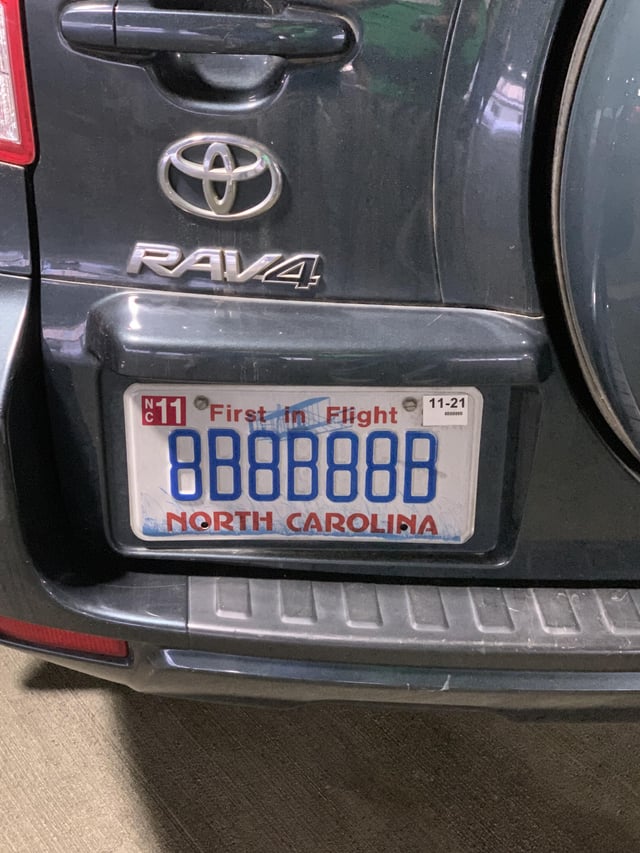
[Other articles in category /misc] permanent link
Tue, 29 Jan 2008
The Census Bureau's data file
Last week I posted an article about calculations
with data provided by the U.S. Census Bureau. I'm thinking about
writing that up in more detail, but today I learned something so
astonishing that I couldn't wait to mention it.
The data is available from the Census Bureau's web site. It is a CSV file. Most of the file contains actual data, like this:
20220,,"Dubuque, IA",Metropolitan Statistical Area,"92,384","91,603","91,223","90,635","89,571","89,216","89,265","89,156","89,143"Experienced data mungers will feel a sense of foreboding as they look at the commas in those numerals. Commas are for people, and if the data file is written for people, rather than for computers, then getting the computer to read it is going to require at least a little bit of suffering. Indeed, the rest of the data is rather dirty. There is a useless header:
table with row headers in column A and column headers in rows 3 through 4 (leading dots indicate sub-parts),,,,,,,,,,,,^M "Table 1. Annual Estimates of the Population of Metropolitan and Micropolitan Statistical Areas: April 1, 2000 to July 1, 2006",,,,,,,,,,,,^M CBSA Code,"Metro Division Code",Geographic area,"Legal/statistical area description",Population estimates,,,,,,,"April 1, 2000",^M ,,,,"July 1, 2006","July 1, 2005","July 1, 2004","July 1, 2003","July 1, 2002","July 1, 2001","July 1, 2000",Estimates base,Census^M ,,Metropolitan statistical areas,,,,,,,,,,^MAnd there is a similarly useless footer on the bottom of the file. Any program that wants to use this data has to trim off the header and the footer, or ignore them, or the user will have to trim them off manually.
(I've translated ASCII CR characters to ^M sequences so that you can see that although the lines of the file are CR-LF terminated, some of the items contain extra LFs for no particular reason.)
Well, all this is minor. My real complaint is that some of the state name abbreviations are garbled:
19740,,"Denver-Aurora, CO1",Metropolitan Statistical Area,"2,408,750","2,361,778","2,326,126","2,299,879","2,276,592","2,245,030","2,193,737","2,179,320","2,179,240"
Notice that it says CO1 rather than CO, short for
"Colorado". I was fortunate to notice this garbling. Since it
occurred on the line for Denver (among others) the result was that the
program was unable to locate the population of Denver, which is the
capital of Colorado, and a mandatory part of the program's output. So
it raised a warning. Then I went in and manually corrected the
CO1 to say CO. I also added a check to the program
to make sure that it recognized all the state abbreviations; I should
have had this in there in the first place.Then I sent email to an acquaintance who works for the Census Bureau (identity suppressed to protect the innocent), pointing out the errors so that they could be corrected.
My contact checked with the people who produced the data, and informed me that, according to them, CO1 was not an error. Rather, the 1 was a footnote mark, directing me to a footnote at the bottom of the file:
"1Broomfield, CO was formed from parts of Adams, Boulder, Jefferson, and Weld Counties, CO on November 15, 2001 and was coextensive with Broomfield city.",,,,,,,,,,,,^M "For purposes of presenting data for metropolitan and micropolitan statistical areas for Census 2000, Broomfield is treated as if it were a county at the time of the 2000 census.",,,,,,,,,,,,^MA footnote.

I would like to suggest the following as a basic principle of computerized data processing:
Data files should contain data.
Not metadata. Not explanations. Not little essays. And not footnotes. Just the data.There's a larger issue here about confusing content and presentation. But "Data files should contain data" is simpler and easier to remember.
I suspect that this file was exported from a spreadsheet program, probably Excel. Spreadsheet programs desperately want you to confuse content and presentation. This is why one should not use a spreadsheet as a database.
I now recall another occasion when I had to deal with data that was exported from a spreadsheet that was pretending to be a database. It was a database of products made by a large cosmetics company. A typical record looked like this:
"Soft-Pressed Powder Blusher","618J-05","Warm, natural-looking powder colour for all skins. Wide range of shades-subtle to vibrant. With applicator brush.","Cheeks","Nudes","Chestnut Blush","All","","19951201","Yes","","14.5",""The 618J-05 here is a product code. Bonus points if you see what's coming next.
"Water-Dissolve Cream Cleanser","6.61E+01","Creamy cleanser for drier, more sensitive skins. Dissolves even the most tenacious makeups.","Cleansers","","","","Sub I, I, II","19951201","Yes","1","14.5",""
That 6.61E+01 should have been 661E-01, but Excel
decided that it was a numeral, in scientific notation, and put it into
normal form.Back to the Census Bureau, which almost screwed me by putting a footnote on a state name. What if they had decided to put footnotes on the population figures? Then I would have been really screwed, because it would have been completely undetectable.
No, wait! It's all become clear. That's why they put the commas in the numerals!
[ Addendum 20080129: My Census Bureau contact tells me that the authors of the data file have seen the wisdom of my point of view, in spite of my unconstructive and unhelpful feedback (I said "Wow, that is an incredibly terrible idea") and are planning to address the issue in the next release of the data. Hooray for happy endings! ]
[ Addendum 20080129: My Census Bureau contact tells me that they do sometimes put footnotes on the data items, so don't laugh too hard at my remark about the commas. ]
[Other articles in category /misc] permanent link
Wed, 23 Jan 2008
Smallest state capitals
I think it was James Kushner who first suggested that I consider the
question of which U.S. state capital had the smallest population in
relation to its state's largest city. For example, New York City is
the largest city in the United States, but the state capital of New
York State is Albany, with a population of about 850,000. The
population of New York City exceeds that of Albany by a factor of
around 20.
At the other end of the scale, of course, we have state capitals like Boston, Denver, Atlanta, and Honolulu that are their state's largest cities. For these states, the population quotient is 1, its theoretical minimum.
Well, James, it only took me thirty years, but here it is.
I tried to resolve the question manually a few weeks ago, by browsing Wikipedia for the populations of likely candidates. Today I took a more methodical approach, downloading the U.S. Census Bureau's July 2006 estimates for populations of metropolitan areas, and writing a couple of little programs to grovel the data.
I had to augment the Census Bureau's data with two items: Annapolis, MD, and Montpelier, VT are not large enough to be included in the metropolitan area data file. I used U.S. Census 2006 estimates for these cities as well.
I discarded one conurbation: the Census Bureau includes a "Metropolitan Division" in New Hampshire that consists of Rockingham and Strafford counties; this was the most populous identified area in New Hampshire. It didn't seem entirely germane to the question, so I took it out. On the other hand, including it doesn't change the results much: its population is 416,000, compared with Manchester-Nashua's 402,000.
The results follow.
| State | Capital and its Population | Largest metropolitan area and its population | Quotient | |||
|---|---|---|---|---|---|---|
| MD | Annapolis | 36,408 | Baltimore-Towson | 2,658,405 | 73 | .02 |
| IL | Springfield | 206,112 | Chicago-Naperville-Joliet | 9,505,748 | 46 | .12 |
| NV | Carson City | 55,289 | Las Vegas-Paradise | 1,777,539 | 32 | .15 |
| VT | Montpelier | 7,954 | Burlington-South Burlington | 206,007 | 25 | .90 |
| NY | Albany | 850,957 | New York-Northern New Jersey-Long Island | 18,818,536 | 22 | .11 |
| MO | Jefferson City | 144,958 | St. Louis | 2,796,368 | 19 | .29 |
| KY | Frankfort | 69,068 | Louisville-Jefferson County | 1,222,216 | 17 | .70 |
| FL | Tallahassee | 336,502 | Miami-Fort Lauderdale-Miami Beach | 5,463,857 | 16 | .24 |
| WA | Olympia | 234,670 | Seattle-Tacoma-Bellevue | 3,263,497 | 13 | .91 |
| AK | Juneau | 30,737 | Anchorage | 359,180 | 11 | .69 |
| PA | Harrisburg | 525,380 | Philadelphia-Camden-Wilmington | 5,826,742 | 11 | .09 |
| SD | Pierre | 19,761 | Sioux Falls | 212,911 | 10 | .77 |
| MI | Lansing | 454,044 | Detroit-Warren-Livonia | 4,468,966 | 9 | .84 |
| NJ | Trenton | 367,605 | Edison | 2,308,777 | 6 | .28 |
| CA | Sacramento | 2,067,117 | Los Angeles-Long Beach-Santa Ana | 12,950,129 | 6 | .26 |
| NM | Santa Fe | 142,407 | Albuquerque | 816,811 | 5 | .74 |
| OR | Salem | 384,600 | Portland-Vancouver-Beaverton | 2,137,565 | 5 | .56 |
| DE | Dover | 147,601 | Wilmington | 691,688 | 4 | .69 |
| VA | Richmond | 1,194,008 | Washington-Arlington-Alexandria | 5,290,400 | 4 | .43 |
| ME | Augusta | 121,068 | Portland-South Portland-Biddeford | 513,667 | 4 | .24 |
| TX | Austin | 1,513,565 | Dallas-Fort Worth-Arlington | 6,003,967 | 3 | .97 |
| AL | Montgomery | 361,748 | Birmingham-Hoover | 1,100,019 | 3 | .04 |
| NE | Lincoln | 283,970 | Omaha-Council Bluffs | 822,549 | 2 | .90 |
| WI | Madison | 543,022 | Milwaukee-Waukesha-West Allis | 1,509,981 | 2 | .78 |
| NH | Concord | 148,085 | Manchester-Nashua | 402,789 | 2 | .72 |
| KS | Topeka | 228,894 | Wichita | 592,126 | 2 | .59 |
| MT | Helena | 70,558 | Billings | 148,116 | 2 | .10 |
| ND | Bismarck | 101,138 | Fargo | 187,001 | 1 | .85 |
| NC | Raleigh | 994,551 | Charlotte-Gastonia-Concord | 1,583,016 | 1 | .59 |
| LA | Baton Rouge | 766,514 | New Orleans-Metairie-Kenner | 1,024,678 | 1 | .34 |
| OH | Columbus | 1,725,570 | Cleveland-Elyria-Mentor | 2,114,155 | 1 | .23 |
| AR | Little Rock | 652,834 | Little Rock-North Little Rock | 652,834 | 1 | .00 |
| AZ | Phoenix | 4,039,182 | Phoenix-Mesa-Scottsdale | 4,039,182 | 1 | .00 |
| CO | Denver | 2,408,750 | Denver-Aurora | 2,408,750 | 1 | .00 |
| CT | Hartford | 1,188,841 | Hartford-West Hartford-East Hartford | 1,188,841 | 1 | .00 |
| GA | Atlanta | 5,138,223 | Atlanta-Sandy Springs-Marietta | 5,138,223 | 1 | .00 |
| HI | Honolulu | 909,863 | Honolulu | 909,863 | 1 | .00 |
| IA | Des Moines | 534,230 | Des Moines-West Des Moines | 534,230 | 1 | .00 |
| ID | Boise | 567,640 | Boise City-Nampa | 567,640 | 1 | .00 |
| IN | Indianapolis | 1,666,032 | Indianapolis-Carmel | 1,666,032 | 1 | .00 |
| MA | Boston | 4,455,217 | Boston-Cambridge-Quincy | 4,455,217 | 1 | .00 |
| MN | St. Paul | 3,175,041 | Minneapolis-St. Paul-Bloomington | 3,175,041 | 1 | .00 |
| MS | Jackson | 529,456 | Jackson | 529,456 | 1 | .00 |
| OK | Oklahoma City | 1,172,339 | Oklahoma City | 1,172,339 | 1 | .00 |
| RI | Providence | 1,612,989 | Providence-New Bedford-Fall River | 1,612,989 | 1 | .00 |
| SC | Columbia | 703,771 | Columbia | 703,771 | 1 | .00 |
| TN | Nashville | 1,455,097 | Nashville-Davidson--Murfreesboro | 1,455,097 | 1 | .00 |
| UT | Salt Lake City | 1,067,722 | Salt Lake City | 1,067,722 | 1 | .00 |
| WV | Charleston | 305,526 | Charleston | 305,526 | 1 | .00 |
| WY | Cheyenne | 85,384 | Cheyenne | 85,384 | 1 | .00 |
Vermont is an interesting outlier here. It makes fourth place not because it has a large city, but because its capital, Montpelier, is so very small. I tried doing some scatter plots, to see if anything else jumped out, but they weren't very illuminating. If anything, the data is suprisingly evenly distributed. Here's an example:

[ Addendum 20080129: Some remarks about the format of the Census Bureau's data file. ]
[ Addendum 20090217: A comparison of the relative sizes of each state's largest and second-largest cities. ]
[Other articles in category /misc] permanent link
Tue, 04 Dec 2007
An Austrian coincidence
Only one of these depicts a location in my obstetrician's
waiting room where the paint is chipped.


[Other articles in category /misc] permanent link
Thu, 13 Sep 2007
Girls of the SEC
I'm in the Raleigh-Durham airport, and I just got back from the
newsstand, where I learned that the pictorial in this month's
Playboy magazine this month is "Girls of the SEC". On
seeing this, I found myself shaking my head in sad puzzlement.
This isn't the first time I've had this reaction on learning about a Playboy pictorial; last time was probably in August 2002 when I saw the "Women of Enron" cover. (I am not making this up.) I wasn't aware of the December 2002 feature, "Women of Worldcom" (I swear I'm not making this up), but I would have had the same reaction if I had been.
I know that in recent years the Playboy franchise has fallen from its former heights of glory: circulation is way down, the Playboy Clubs have all closed, few people still carry Playboy keychains. But I didn't remember that they had fallen quite so far. They seem to have exhausted all the plausible topics for pictorial features, and are now well into the scraping-the-bottom-of-the-barrel stage. The June 1968 feature was "Girls of Scandinavia". July 1999, "Girls of Hawaiian Tropic". Then "Women of Enron" and now "Girls of the SEC".
How many men have ever had a fantasy about sexy SEC employees, anyway? How can you even tell? Sexy flight attendants, sure; they wear recognizable uniforms. But what characterizes an SEC employee? A rumpled flannel suit? An interest in cost accounting? A tendency to talk about the new Basel II banking regulations? I tried to think of a category that would be less sexually inspiring than "SEC employees". It's difficult. My first thought was "Girls of Wal-Mart." But no, Wal-Mart employees wear uniforms.
If you go too far in that direction you end up in the realm of fetish. For example, Playboy is unlikely to do a feature on "girls of the infectious disease wards". But if they did, there is someone (probably on /b/), who would be extremely interested. It is hard to imagine anyone with a similarly intense interest in SEC employees.
So what's next for Playboy? Girls of the hospital gift shops? Girls of State Farm Insurance telephone customer service division? Girls of the beet canneries? Girls of Acadia University Grounds and Facilities Services? Girls of the DMV?
[ Pre-publication addendum: After a little more research, I figured out that SEC refers here to "Southeastern Conference" and that Playboy has done at least two other features with the same title, most recently in October 2001. I decided to run the article anyway, since I think I wouldn't have made the mistake if I hadn't been prepared ahead of time by "Women of Enron". ]
[ Addendum 20070913: This article is now on the first page of Google searches for "girls of the sec playboy". ]
[ Addendum 20070915: The article has moved up from tenth to third place. Truly, Google works in mysterious ways. ]
[Other articles in category /misc] permanent link
Fri, 20 Jul 2007
Tough questions
It's easy to recognize a good question: a good question is one that
takes a lot longer to answer than it does to ask. Chip Buchholtz's
example is "what is a byte?" To answer that you have to get into the
nitty gritty of computer architecture and how, although the
information in the computer is stored by the bit, the memory bus can
only address it by the byte.
One of the biology interns asked a me a good one a couple of weeks ago: he asked how, if Perl runs Perl scripts, and the OS is running Perl, what is running the OS? Now that is a tough question to answer. I explained about logic gates, and how the logic gates are built into trivial arithmetic and memory circuits, how these are then built up into ALUs and memories, and how these in turn are controlled by microcode, and finally how the logical parts are assembled into a computer. I don't know how understandable it was, but it was the best I could do in five minutes, and I think I got some of the idea across. But I started and finished by saying that it was basically miraculous.
My daughter Katara asks a ton of questions, some better than others. On any given evening she is likely to ask "Daddy, what are you doing?" about fifteen times, and "why?" about fifteen million times. "Why" can be a great question, but sometimes it's not so great; Katara asks both kinds. Sometimes it's in response to "I'm eating a sandwich." Then the inevitable "why?" is rather annoying.
Some of the "why" questions are nearly impossible to answer. For example, we see a lady coming up the street toward us. "Is that Susanna?" "No." "Why is it not Susanna?"
I think what's happening here is that having discovered this magic word that often produces interesting information, Katara is employing it whenever possible, even when it doesn't make sense, because she hasn't yet learned when it works and when not. Why is that not Susanna? Hey, you never know when you might get an interesting answer. But there might be something else going on that I don't appreciate.
But the nice thing about Katara's incessant questions is that she listens to and remembers the answers, ponders them deeply, and then is likely to come back with an insightful followup when you least expect it.
This weekend we went to visit my parents in New York, and as we drove down the Henry Hudson Parkway, we passed the North River wastewater treatment plant. Three-year-olds are fascinated with poop, so I took the opportunity to point out the plant to Katara. I said that although it had a park with trees on the roof, the inside was a giant machine for turning poop into garden soil; they cleaned it and mixed with with wood chips and it composted like the stuff in our composter. (I later found that some of these details were not quite accurate, but the general idea is correct. See the official site for the official story. My wife provided the helpful analogy with the composter.) As I expected, Katara was interested, and thought this over; she confirmed that they turned poop into soil, and then asked what they made pee into. I was not prepared for that one, and I had to promise her I would find out later. It took me some Internet research time to find out about denitrogenation.
Speaking of poop, last month Katara asked a puzzler: why don't birds use toilets? I think this was motivated by our earlier discussion of bird poop on our car.
In Make Way for Ducklings there's a picture of the friendly policeman Michael, running back to his police box to order a police escort to help the ducklings across Beacon Street. He's holding his billy club. Katara asked what that was for. I thought a moment, and then said "It's for hitting people with." Later I wondered if I had given an inaccurate or incomplete answer, so I asked around, and did some reading. It appears I got that one right. Some folks I know suggested that I should have said it was for hitting bad people, but I'd rather stick to the plain facts, and leave out the editorializing.
So I was reading the Mattingly book this evening, and Katara was eating and playing with Play-Doh on the kitchen floor. After the eleventh repetition of "Daddy, what are you doing?" "Reading." I decided to tell Katara what I was reading about. I said that I was reading about ships, that ships are big boats; they carry lots of men and guns. Katara asked why they carried guns, and I explained that often the ships carried treasure, like spices or gold or jewels or cloth, and that pirates tried to steal it. Katara asked if the cloth was like a wash cloth, and I said no, it was more like the kind of cloth that Mommy makes quilts from, or like the silk that her silk dress is made of. I explained about the pirates, which she seemed to understand, because toddlers know all about people who try to take stuff that isn't theirs. And then she asked the question I couldn't answer: Why were there men on the ships, but no women?
I was totally stumped; I don't even know where to begin explaining to a three-year-old why there are no women on ships in 1588. The only answers I could think of had to do with women's traditional roles, with European mores, social constructions of gender, and so on, all stuff that wouldn't help. Sometimes women were smuggled aboard ship, but I wasn't going to say that either.
I don't usually give up, but this time I gave up. This is a tough question of the first order, easy to ask, hard to answer. It's a lot easier to explain wastewater treatment.
[Other articles in category /misc] permanent link





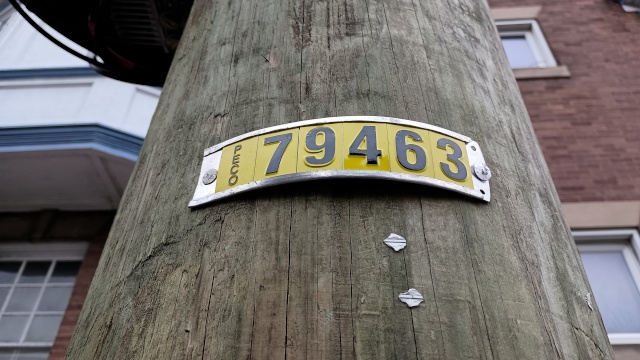
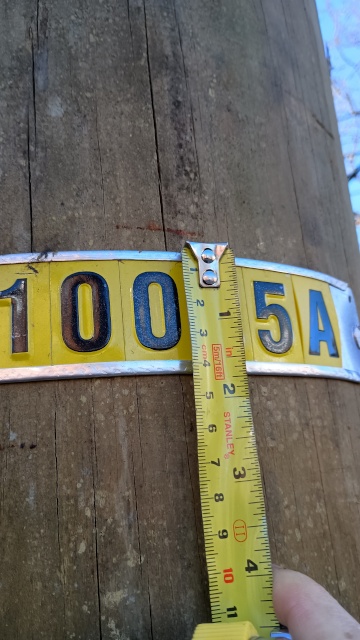






























-th.jpg)





